Strategic Marketing Management of Nestle Global
VerifiedAdded on 2023/01/13
|26
|5582
|71
AI Summary
This report discusses the strategic marketing management of Nestle Global in India, including the macro and micro environment, marketing plans, and the role of marketing in achieving organizational goals.
Contribute Materials
Your contribution can guide someone’s learning journey. Share your
documents today.
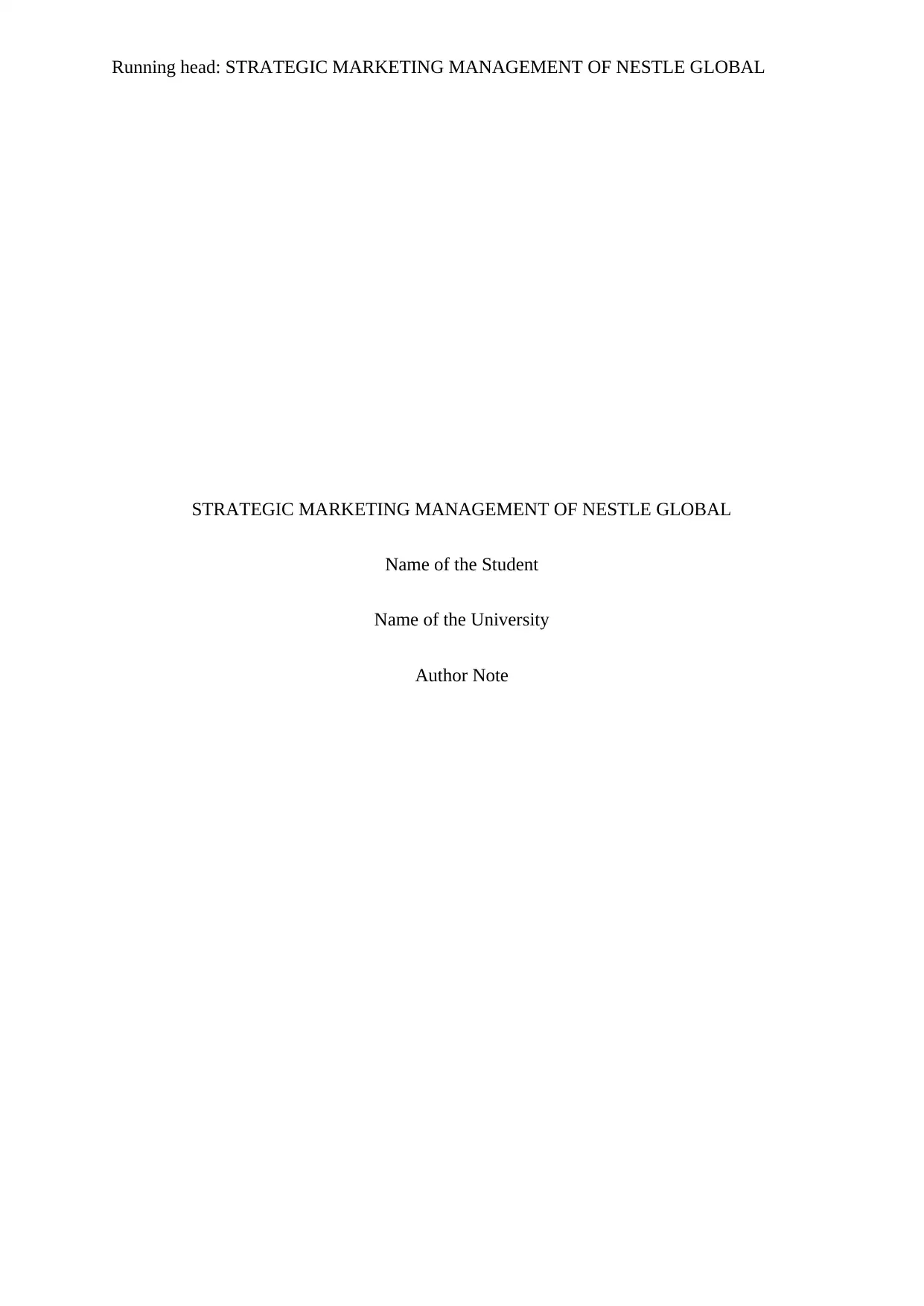
Running head: STRATEGIC MARKETING MANAGEMENT OF NESTLE GLOBAL
STRATEGIC MARKETING MANAGEMENT OF NESTLE GLOBAL
Name of the Student
Name of the University
Author Note
STRATEGIC MARKETING MANAGEMENT OF NESTLE GLOBAL
Name of the Student
Name of the University
Author Note
Secure Best Marks with AI Grader
Need help grading? Try our AI Grader for instant feedback on your assignments.
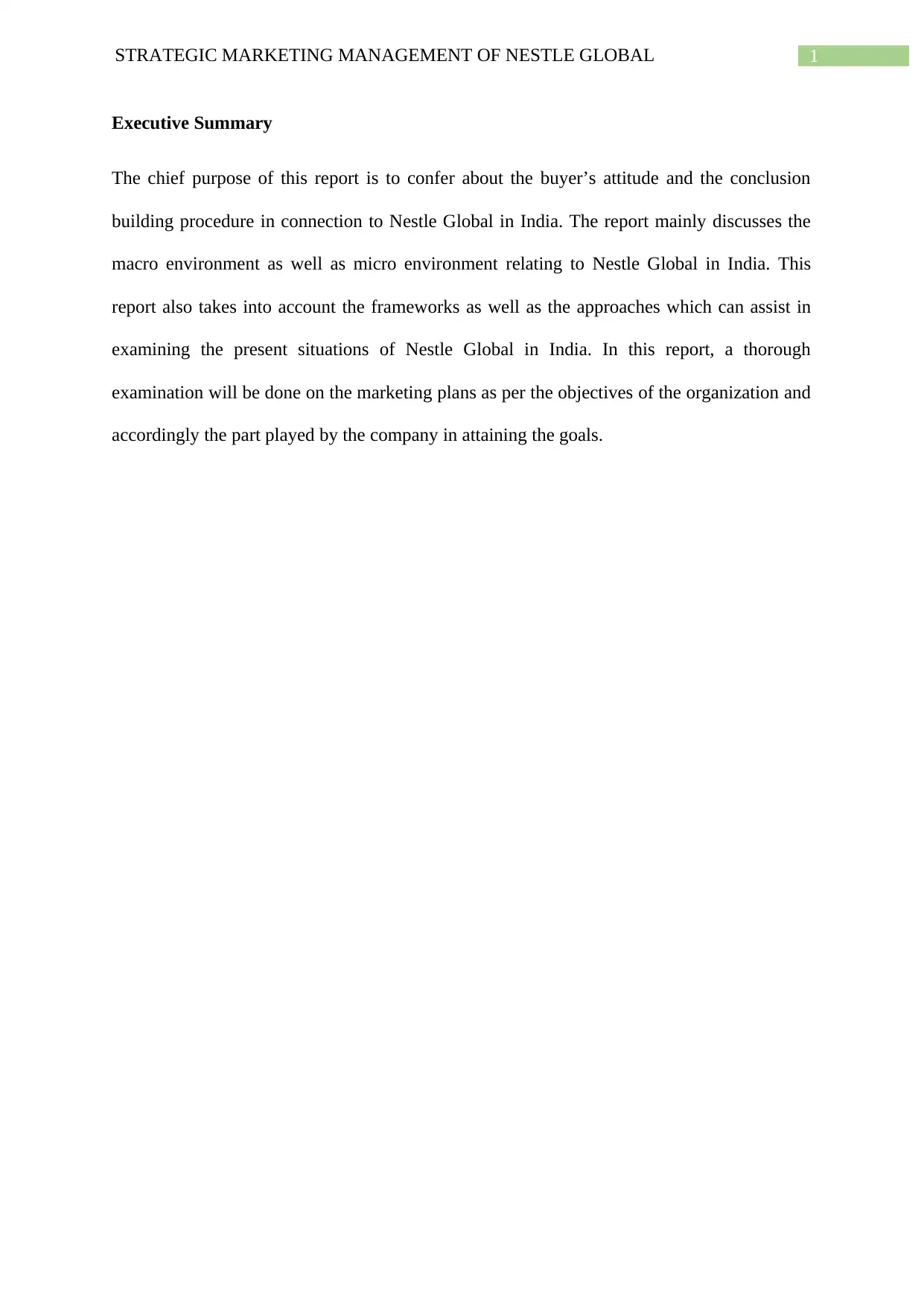
1STRATEGIC MARKETING MANAGEMENT OF NESTLE GLOBAL
Executive Summary
The chief purpose of this report is to confer about the buyer’s attitude and the conclusion
building procedure in connection to Nestle Global in India. The report mainly discusses the
macro environment as well as micro environment relating to Nestle Global in India. This
report also takes into account the frameworks as well as the approaches which can assist in
examining the present situations of Nestle Global in India. In this report, a thorough
examination will be done on the marketing plans as per the objectives of the organization and
accordingly the part played by the company in attaining the goals.
Executive Summary
The chief purpose of this report is to confer about the buyer’s attitude and the conclusion
building procedure in connection to Nestle Global in India. The report mainly discusses the
macro environment as well as micro environment relating to Nestle Global in India. This
report also takes into account the frameworks as well as the approaches which can assist in
examining the present situations of Nestle Global in India. In this report, a thorough
examination will be done on the marketing plans as per the objectives of the organization and
accordingly the part played by the company in attaining the goals.
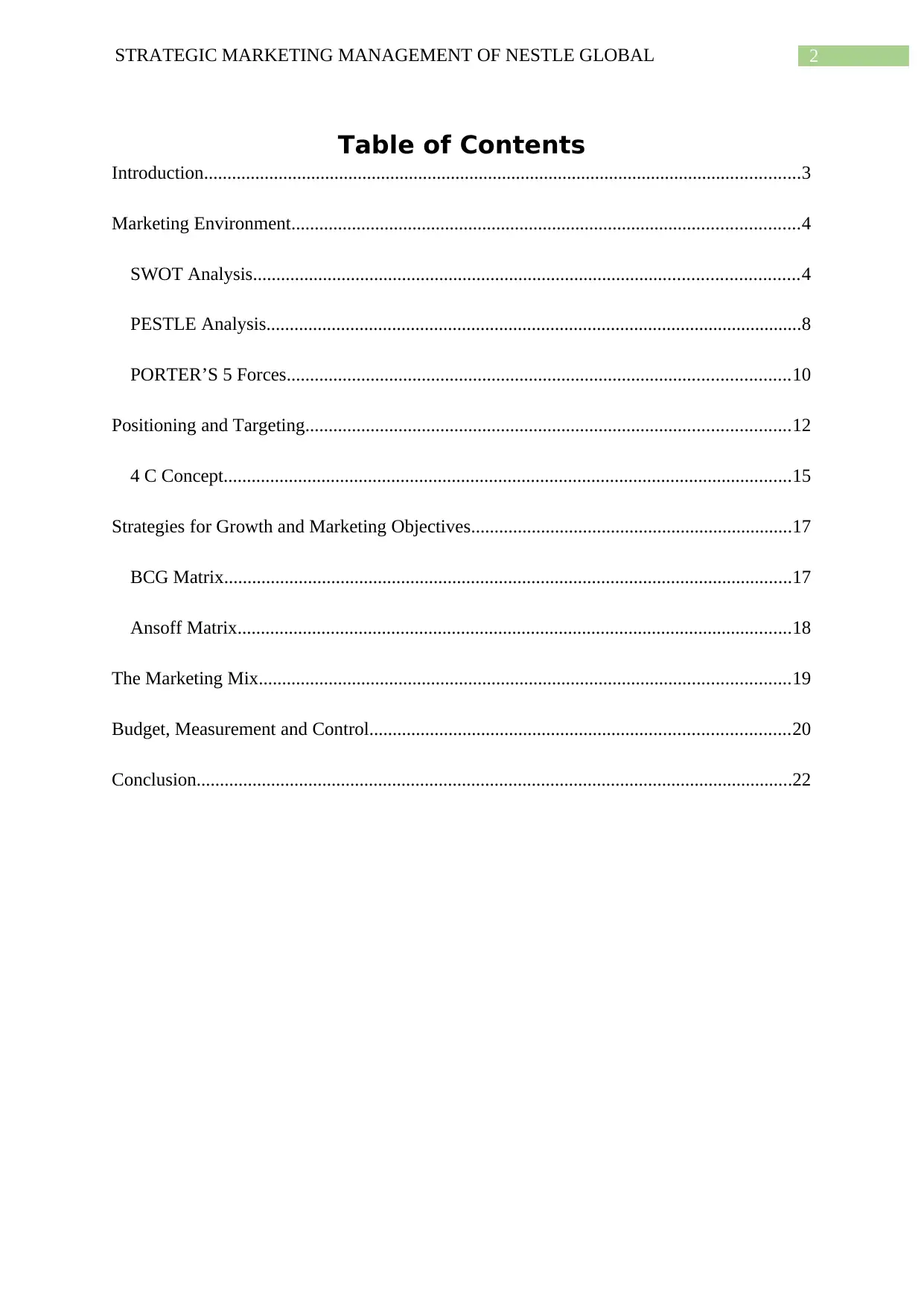
2STRATEGIC MARKETING MANAGEMENT OF NESTLE GLOBAL
Table of Contents
Introduction................................................................................................................................3
Marketing Environment.............................................................................................................4
SWOT Analysis.....................................................................................................................4
PESTLE Analysis...................................................................................................................8
PORTER’S 5 Forces............................................................................................................10
Positioning and Targeting........................................................................................................12
4 C Concept..........................................................................................................................15
Strategies for Growth and Marketing Objectives.....................................................................17
BCG Matrix..........................................................................................................................17
Ansoff Matrix.......................................................................................................................18
The Marketing Mix..................................................................................................................19
Budget, Measurement and Control..........................................................................................20
Conclusion................................................................................................................................22
Table of Contents
Introduction................................................................................................................................3
Marketing Environment.............................................................................................................4
SWOT Analysis.....................................................................................................................4
PESTLE Analysis...................................................................................................................8
PORTER’S 5 Forces............................................................................................................10
Positioning and Targeting........................................................................................................12
4 C Concept..........................................................................................................................15
Strategies for Growth and Marketing Objectives.....................................................................17
BCG Matrix..........................................................................................................................17
Ansoff Matrix.......................................................................................................................18
The Marketing Mix..................................................................................................................19
Budget, Measurement and Control..........................................................................................20
Conclusion................................................................................................................................22
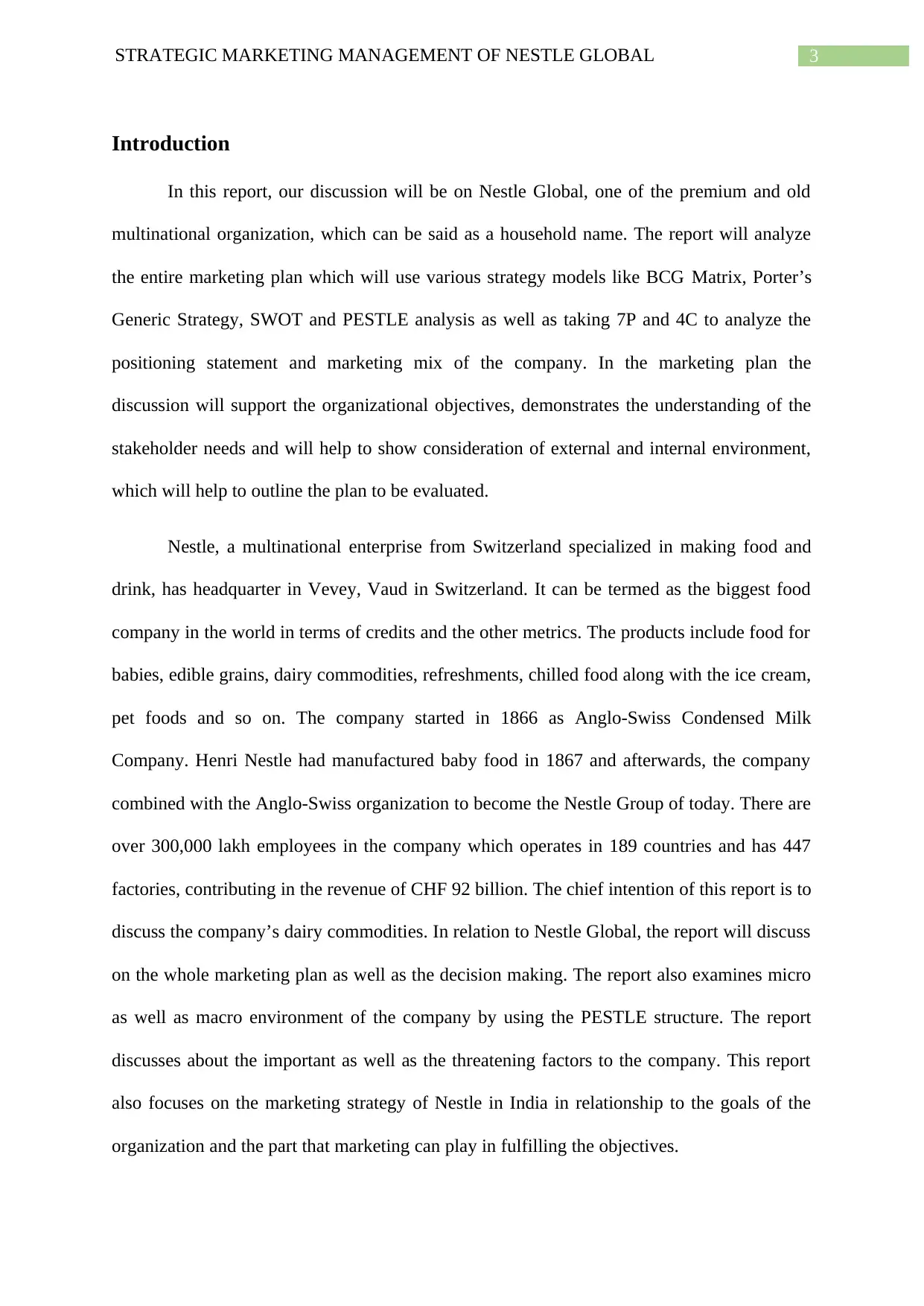
3STRATEGIC MARKETING MANAGEMENT OF NESTLE GLOBAL
Introduction
In this report, our discussion will be on Nestle Global, one of the premium and old
multinational organization, which can be said as a household name. The report will analyze
the entire marketing plan which will use various strategy models like BCG Matrix, Porter’s
Generic Strategy, SWOT and PESTLE analysis as well as taking 7P and 4C to analyze the
positioning statement and marketing mix of the company. In the marketing plan the
discussion will support the organizational objectives, demonstrates the understanding of the
stakeholder needs and will help to show consideration of external and internal environment,
which will help to outline the plan to be evaluated.
Nestle, a multinational enterprise from Switzerland specialized in making food and
drink, has headquarter in Vevey, Vaud in Switzerland. It can be termed as the biggest food
company in the world in terms of credits and the other metrics. The products include food for
babies, edible grains, dairy commodities, refreshments, chilled food along with the ice cream,
pet foods and so on. The company started in 1866 as Anglo-Swiss Condensed Milk
Company. Henri Nestle had manufactured baby food in 1867 and afterwards, the company
combined with the Anglo-Swiss organization to become the Nestle Group of today. There are
over 300,000 lakh employees in the company which operates in 189 countries and has 447
factories, contributing in the revenue of CHF 92 billion. The chief intention of this report is to
discuss the company’s dairy commodities. In relation to Nestle Global, the report will discuss
on the whole marketing plan as well as the decision making. The report also examines micro
as well as macro environment of the company by using the PESTLE structure. The report
discusses about the important as well as the threatening factors to the company. This report
also focuses on the marketing strategy of Nestle in India in relationship to the goals of the
organization and the part that marketing can play in fulfilling the objectives.
Introduction
In this report, our discussion will be on Nestle Global, one of the premium and old
multinational organization, which can be said as a household name. The report will analyze
the entire marketing plan which will use various strategy models like BCG Matrix, Porter’s
Generic Strategy, SWOT and PESTLE analysis as well as taking 7P and 4C to analyze the
positioning statement and marketing mix of the company. In the marketing plan the
discussion will support the organizational objectives, demonstrates the understanding of the
stakeholder needs and will help to show consideration of external and internal environment,
which will help to outline the plan to be evaluated.
Nestle, a multinational enterprise from Switzerland specialized in making food and
drink, has headquarter in Vevey, Vaud in Switzerland. It can be termed as the biggest food
company in the world in terms of credits and the other metrics. The products include food for
babies, edible grains, dairy commodities, refreshments, chilled food along with the ice cream,
pet foods and so on. The company started in 1866 as Anglo-Swiss Condensed Milk
Company. Henri Nestle had manufactured baby food in 1867 and afterwards, the company
combined with the Anglo-Swiss organization to become the Nestle Group of today. There are
over 300,000 lakh employees in the company which operates in 189 countries and has 447
factories, contributing in the revenue of CHF 92 billion. The chief intention of this report is to
discuss the company’s dairy commodities. In relation to Nestle Global, the report will discuss
on the whole marketing plan as well as the decision making. The report also examines micro
as well as macro environment of the company by using the PESTLE structure. The report
discusses about the important as well as the threatening factors to the company. This report
also focuses on the marketing strategy of Nestle in India in relationship to the goals of the
organization and the part that marketing can play in fulfilling the objectives.
Secure Best Marks with AI Grader
Need help grading? Try our AI Grader for instant feedback on your assignments.
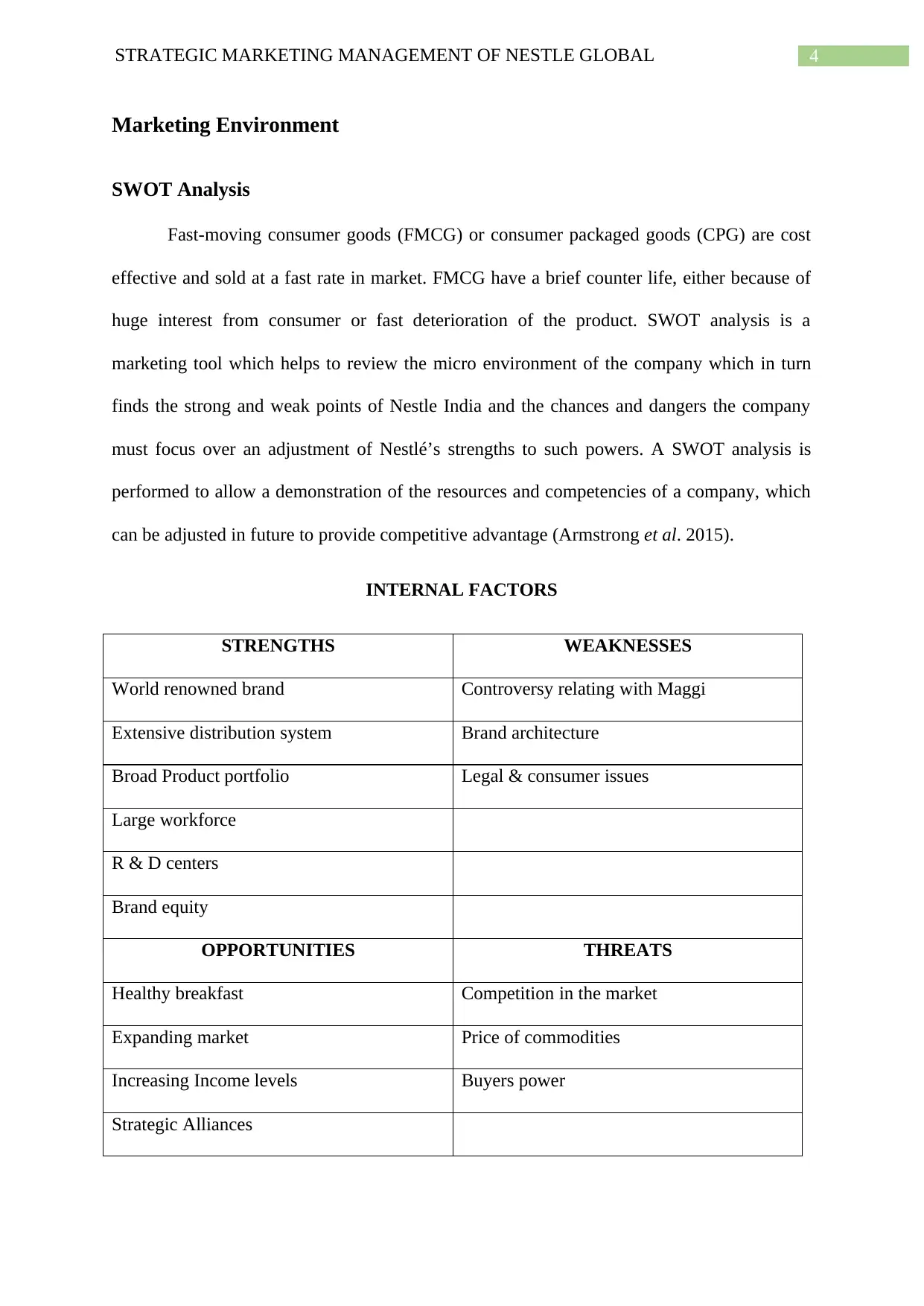
4STRATEGIC MARKETING MANAGEMENT OF NESTLE GLOBAL
Marketing Environment
SWOT Analysis
Fast-moving consumer goods (FMCG) or consumer packaged goods (CPG) are cost
effective and sold at a fast rate in market. FMCG have a brief counter life, either because of
huge interest from consumer or fast deterioration of the product. SWOT analysis is a
marketing tool which helps to review the micro environment of the company which in turn
finds the strong and weak points of Nestle India and the chances and dangers the company
must focus over an adjustment of Nestlé’s strengths to such powers. A SWOT analysis is
performed to allow a demonstration of the resources and competencies of a company, which
can be adjusted in future to provide competitive advantage (Armstrong et al. 2015).
INTERNAL FACTORS
STRENGTHS WEAKNESSES
World renowned brand Controversy relating with Maggi
Extensive distribution system Brand architecture
Broad Product portfolio Legal & consumer issues
Large workforce
R & D centers
Brand equity
OPPORTUNITIES THREATS
Healthy breakfast Competition in the market
Expanding market Price of commodities
Increasing Income levels Buyers power
Strategic Alliances
Marketing Environment
SWOT Analysis
Fast-moving consumer goods (FMCG) or consumer packaged goods (CPG) are cost
effective and sold at a fast rate in market. FMCG have a brief counter life, either because of
huge interest from consumer or fast deterioration of the product. SWOT analysis is a
marketing tool which helps to review the micro environment of the company which in turn
finds the strong and weak points of Nestle India and the chances and dangers the company
must focus over an adjustment of Nestlé’s strengths to such powers. A SWOT analysis is
performed to allow a demonstration of the resources and competencies of a company, which
can be adjusted in future to provide competitive advantage (Armstrong et al. 2015).
INTERNAL FACTORS
STRENGTHS WEAKNESSES
World renowned brand Controversy relating with Maggi
Extensive distribution system Brand architecture
Broad Product portfolio Legal & consumer issues
Large workforce
R & D centers
Brand equity
OPPORTUNITIES THREATS
Healthy breakfast Competition in the market
Expanding market Price of commodities
Increasing Income levels Buyers power
Strategic Alliances
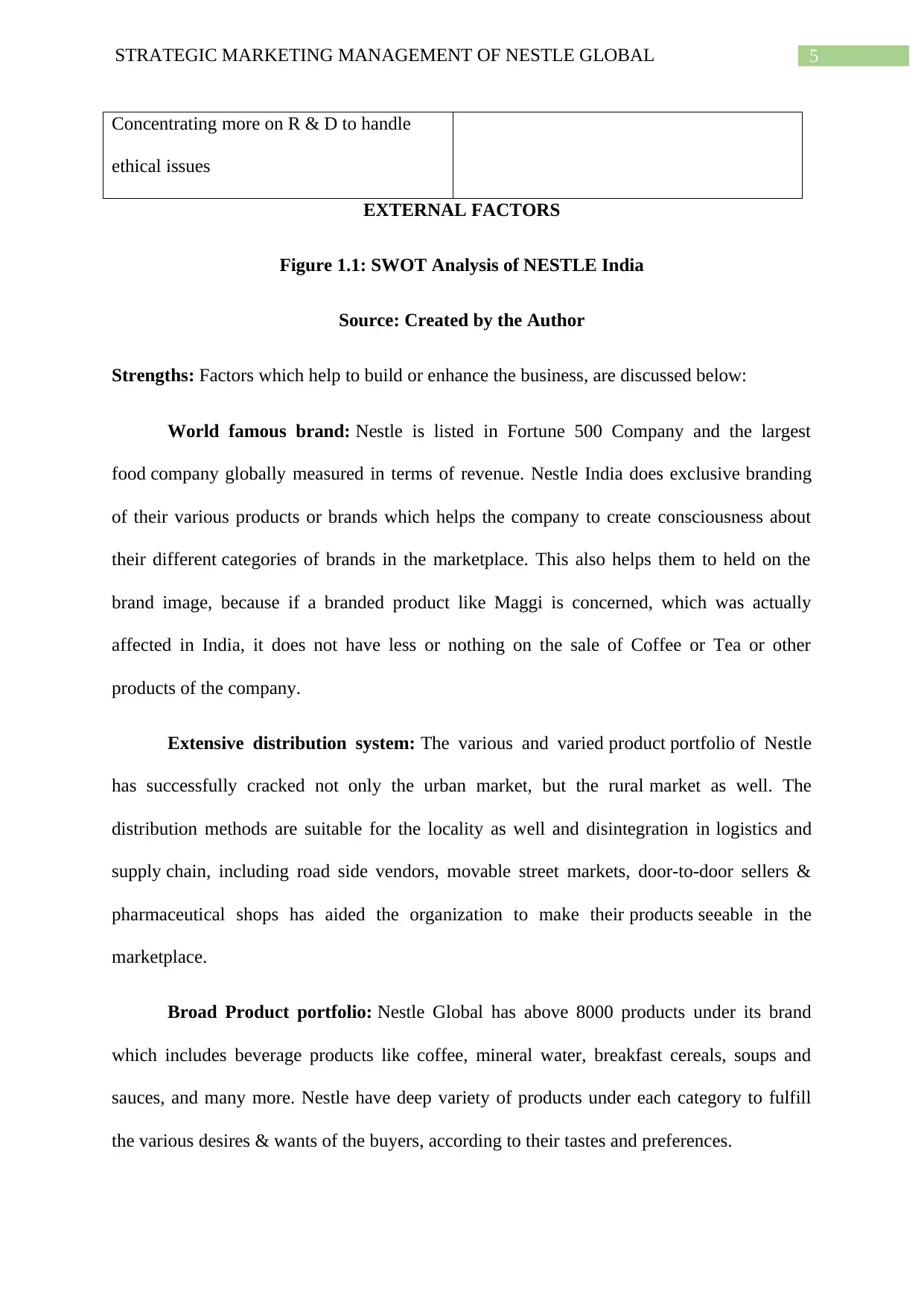
5STRATEGIC MARKETING MANAGEMENT OF NESTLE GLOBAL
Concentrating more on R & D to handle
ethical issues
EXTERNAL FACTORS
Figure 1.1: SWOT Analysis of NESTLE India
Source: Created by the Author
Strengths: Factors which help to build or enhance the business, are discussed below:
World famous brand: Nestle is listed in Fortune 500 Company and the largest
food company globally measured in terms of revenue. Nestle India does exclusive branding
of their various products or brands which helps the company to create consciousness about
their different categories of brands in the marketplace. This also helps them to held on the
brand image, because if a branded product like Maggi is concerned, which was actually
affected in India, it does not have less or nothing on the sale of Coffee or Tea or other
products of the company.
Extensive distribution system: The various and varied product portfolio of Nestle
has successfully cracked not only the urban market, but the rural market as well. The
distribution methods are suitable for the locality as well and disintegration in logistics and
supply chain, including road side vendors, movable street markets, door-to-door sellers &
pharmaceutical shops has aided the organization to make their products seeable in the
marketplace.
Broad Product portfolio: Nestle Global has above 8000 products under its brand
which includes beverage products like coffee, mineral water, breakfast cereals, soups and
sauces, and many more. Nestle have deep variety of products under each category to fulfill
the various desires & wants of the buyers, according to their tastes and preferences.
Concentrating more on R & D to handle
ethical issues
EXTERNAL FACTORS
Figure 1.1: SWOT Analysis of NESTLE India
Source: Created by the Author
Strengths: Factors which help to build or enhance the business, are discussed below:
World famous brand: Nestle is listed in Fortune 500 Company and the largest
food company globally measured in terms of revenue. Nestle India does exclusive branding
of their various products or brands which helps the company to create consciousness about
their different categories of brands in the marketplace. This also helps them to held on the
brand image, because if a branded product like Maggi is concerned, which was actually
affected in India, it does not have less or nothing on the sale of Coffee or Tea or other
products of the company.
Extensive distribution system: The various and varied product portfolio of Nestle
has successfully cracked not only the urban market, but the rural market as well. The
distribution methods are suitable for the locality as well and disintegration in logistics and
supply chain, including road side vendors, movable street markets, door-to-door sellers &
pharmaceutical shops has aided the organization to make their products seeable in the
marketplace.
Broad Product portfolio: Nestle Global has above 8000 products under its brand
which includes beverage products like coffee, mineral water, breakfast cereals, soups and
sauces, and many more. Nestle have deep variety of products under each category to fulfill
the various desires & wants of the buyers, according to their tastes and preferences.
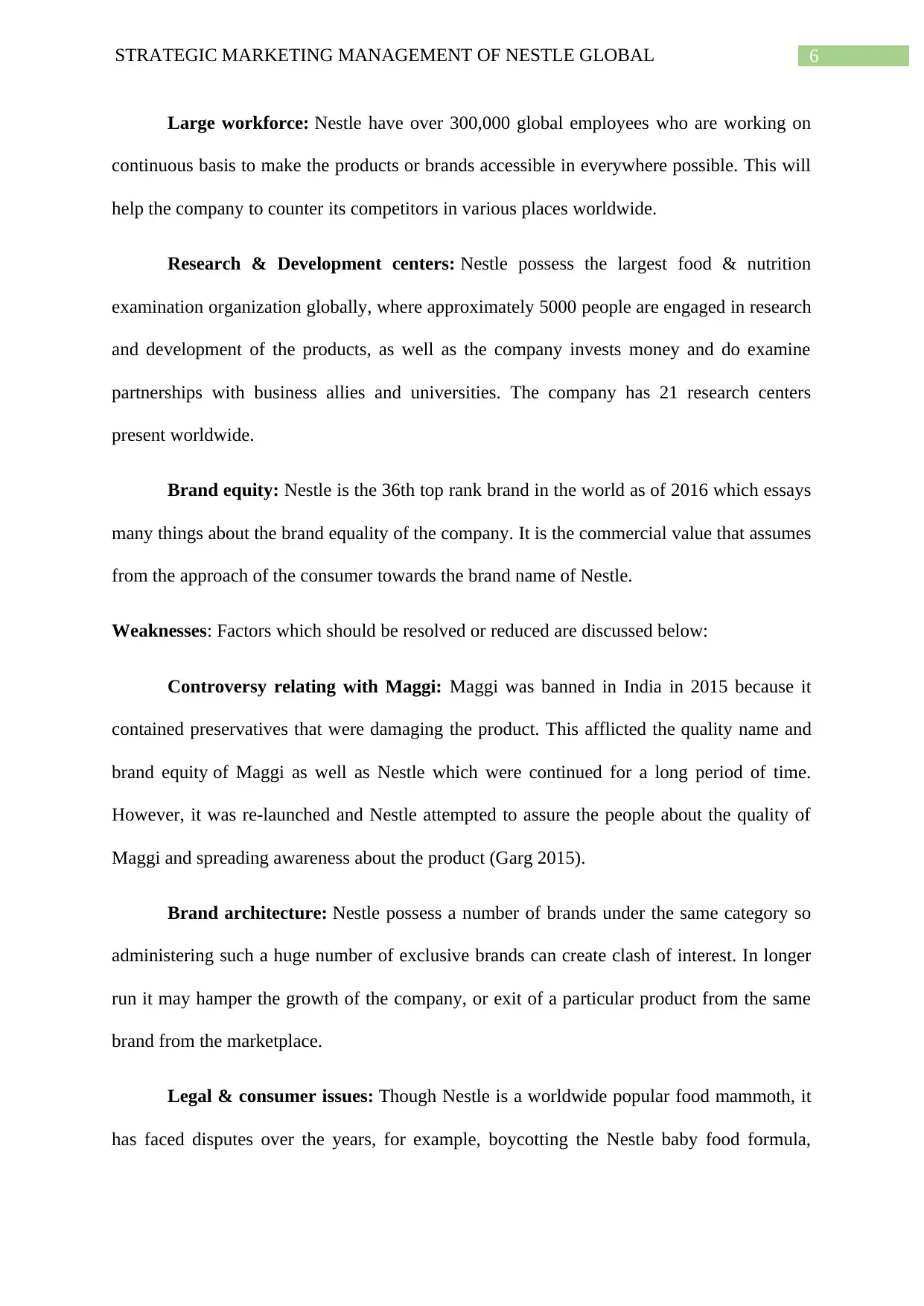
6STRATEGIC MARKETING MANAGEMENT OF NESTLE GLOBAL
Large workforce: Nestle have over 300,000 global employees who are working on
continuous basis to make the products or brands accessible in everywhere possible. This will
help the company to counter its competitors in various places worldwide.
Research & Development centers: Nestle possess the largest food & nutrition
examination organization globally, where approximately 5000 people are engaged in research
and development of the products, as well as the company invests money and do examine
partnerships with business allies and universities. The company has 21 research centers
present worldwide.
Brand equity: Nestle is the 36th top rank brand in the world as of 2016 which essays
many things about the brand equality of the company. It is the commercial value that assumes
from the approach of the consumer towards the brand name of Nestle.
Weaknesses: Factors which should be resolved or reduced are discussed below:
Controversy relating with Maggi: Maggi was banned in India in 2015 because it
contained preservatives that were damaging the product. This afflicted the quality name and
brand equity of Maggi as well as Nestle which were continued for a long period of time.
However, it was re-launched and Nestle attempted to assure the people about the quality of
Maggi and spreading awareness about the product (Garg 2015).
Brand architecture: Nestle possess a number of brands under the same category so
administering such a huge number of exclusive brands can create clash of interest. In longer
run it may hamper the growth of the company, or exit of a particular product from the same
brand from the marketplace.
Legal & consumer issues: Though Nestle is a worldwide popular food mammoth, it
has faced disputes over the years, for example, boycotting the Nestle baby food formula,
Large workforce: Nestle have over 300,000 global employees who are working on
continuous basis to make the products or brands accessible in everywhere possible. This will
help the company to counter its competitors in various places worldwide.
Research & Development centers: Nestle possess the largest food & nutrition
examination organization globally, where approximately 5000 people are engaged in research
and development of the products, as well as the company invests money and do examine
partnerships with business allies and universities. The company has 21 research centers
present worldwide.
Brand equity: Nestle is the 36th top rank brand in the world as of 2016 which essays
many things about the brand equality of the company. It is the commercial value that assumes
from the approach of the consumer towards the brand name of Nestle.
Weaknesses: Factors which should be resolved or reduced are discussed below:
Controversy relating with Maggi: Maggi was banned in India in 2015 because it
contained preservatives that were damaging the product. This afflicted the quality name and
brand equity of Maggi as well as Nestle which were continued for a long period of time.
However, it was re-launched and Nestle attempted to assure the people about the quality of
Maggi and spreading awareness about the product (Garg 2015).
Brand architecture: Nestle possess a number of brands under the same category so
administering such a huge number of exclusive brands can create clash of interest. In longer
run it may hamper the growth of the company, or exit of a particular product from the same
brand from the marketplace.
Legal & consumer issues: Though Nestle is a worldwide popular food mammoth, it
has faced disputes over the years, for example, boycotting the Nestle baby food formula,
Paraphrase This Document
Need a fresh take? Get an instant paraphrase of this document with our AI Paraphraser
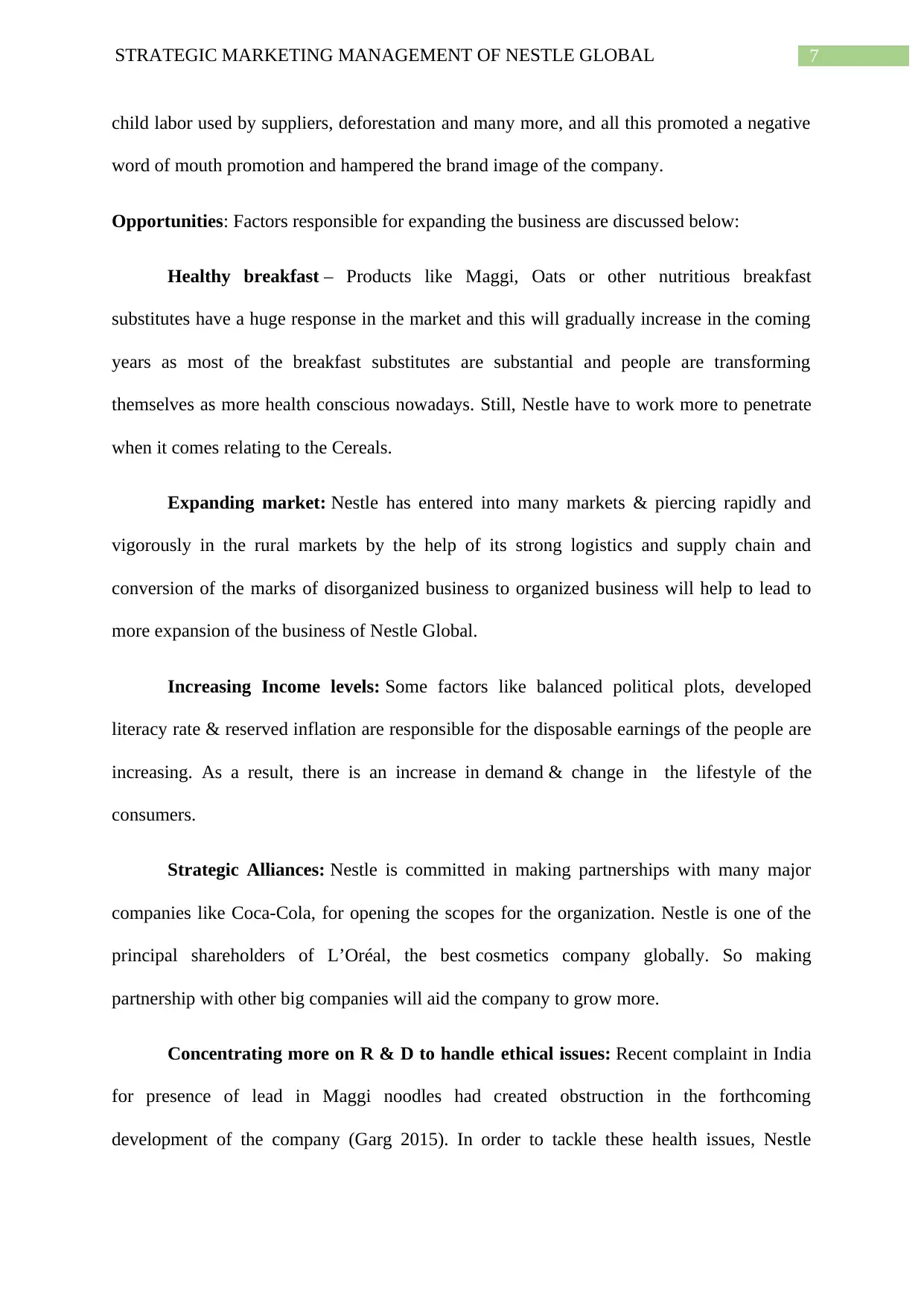
7STRATEGIC MARKETING MANAGEMENT OF NESTLE GLOBAL
child labor used by suppliers, deforestation and many more, and all this promoted a negative
word of mouth promotion and hampered the brand image of the company.
Opportunities: Factors responsible for expanding the business are discussed below:
Healthy breakfast – Products like Maggi, Oats or other nutritious breakfast
substitutes have a huge response in the market and this will gradually increase in the coming
years as most of the breakfast substitutes are substantial and people are transforming
themselves as more health conscious nowadays. Still, Nestle have to work more to penetrate
when it comes relating to the Cereals.
Expanding market: Nestle has entered into many markets & piercing rapidly and
vigorously in the rural markets by the help of its strong logistics and supply chain and
conversion of the marks of disorganized business to organized business will help to lead to
more expansion of the business of Nestle Global.
Increasing Income levels: Some factors like balanced political plots, developed
literacy rate & reserved inflation are responsible for the disposable earnings of the people are
increasing. As a result, there is an increase in demand & change in the lifestyle of the
consumers.
Strategic Alliances: Nestle is committed in making partnerships with many major
companies like Coca-Cola, for opening the scopes for the organization. Nestle is one of the
principal shareholders of L’Oréal, the best cosmetics company globally. So making
partnership with other big companies will aid the company to grow more.
Concentrating more on R & D to handle ethical issues: Recent complaint in India
for presence of lead in Maggi noodles had created obstruction in the forthcoming
development of the company (Garg 2015). In order to tackle these health issues, Nestle
child labor used by suppliers, deforestation and many more, and all this promoted a negative
word of mouth promotion and hampered the brand image of the company.
Opportunities: Factors responsible for expanding the business are discussed below:
Healthy breakfast – Products like Maggi, Oats or other nutritious breakfast
substitutes have a huge response in the market and this will gradually increase in the coming
years as most of the breakfast substitutes are substantial and people are transforming
themselves as more health conscious nowadays. Still, Nestle have to work more to penetrate
when it comes relating to the Cereals.
Expanding market: Nestle has entered into many markets & piercing rapidly and
vigorously in the rural markets by the help of its strong logistics and supply chain and
conversion of the marks of disorganized business to organized business will help to lead to
more expansion of the business of Nestle Global.
Increasing Income levels: Some factors like balanced political plots, developed
literacy rate & reserved inflation are responsible for the disposable earnings of the people are
increasing. As a result, there is an increase in demand & change in the lifestyle of the
consumers.
Strategic Alliances: Nestle is committed in making partnerships with many major
companies like Coca-Cola, for opening the scopes for the organization. Nestle is one of the
principal shareholders of L’Oréal, the best cosmetics company globally. So making
partnership with other big companies will aid the company to grow more.
Concentrating more on R & D to handle ethical issues: Recent complaint in India
for presence of lead in Maggi noodles had created obstruction in the forthcoming
development of the company (Garg 2015). In order to tackle these health issues, Nestle
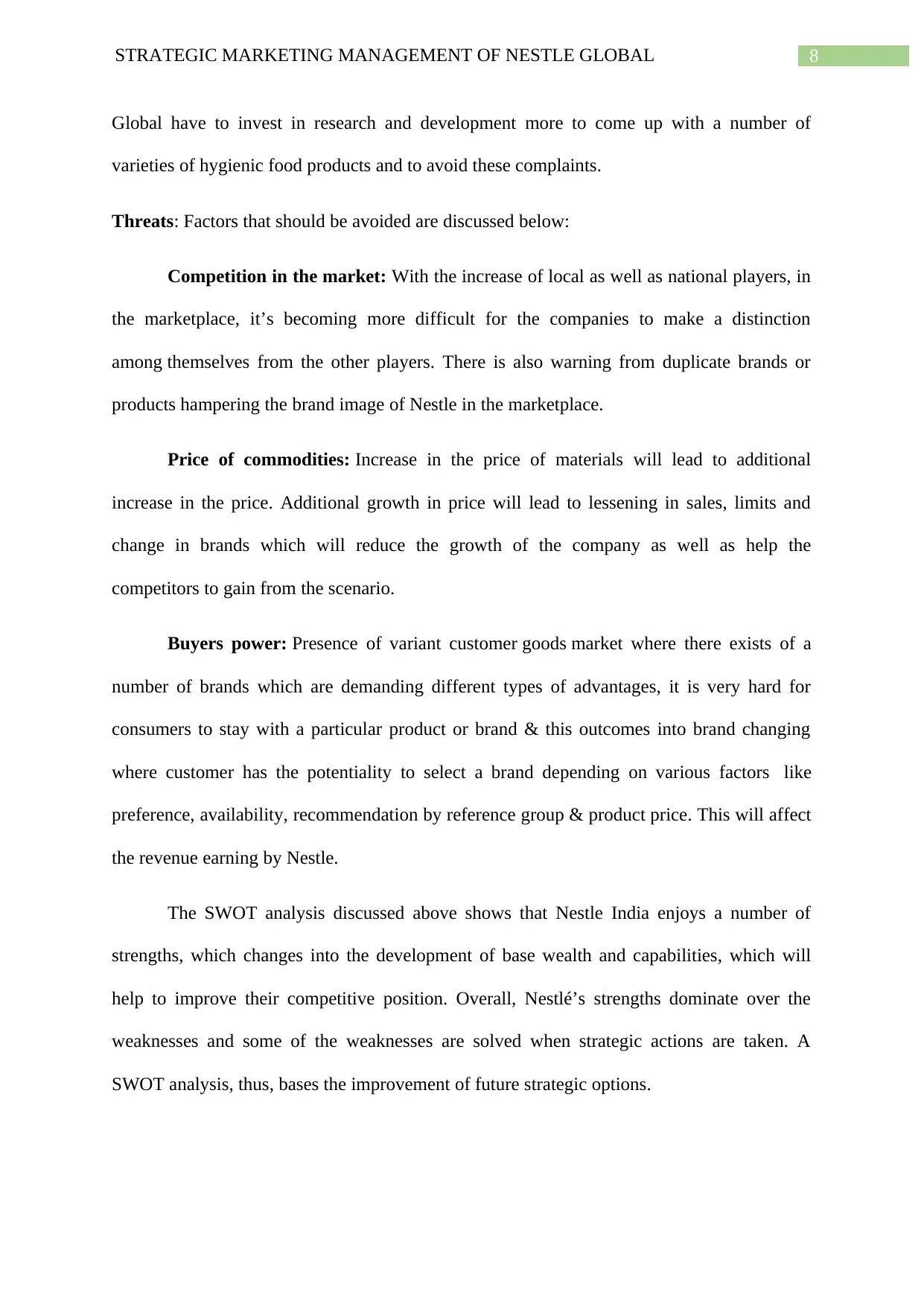
8STRATEGIC MARKETING MANAGEMENT OF NESTLE GLOBAL
Global have to invest in research and development more to come up with a number of
varieties of hygienic food products and to avoid these complaints.
Threats: Factors that should be avoided are discussed below:
Competition in the market: With the increase of local as well as national players, in
the marketplace, it’s becoming more difficult for the companies to make a distinction
among themselves from the other players. There is also warning from duplicate brands or
products hampering the brand image of Nestle in the marketplace.
Price of commodities: Increase in the price of materials will lead to additional
increase in the price. Additional growth in price will lead to lessening in sales, limits and
change in brands which will reduce the growth of the company as well as help the
competitors to gain from the scenario.
Buyers power: Presence of variant customer goods market where there exists of a
number of brands which are demanding different types of advantages, it is very hard for
consumers to stay with a particular product or brand & this outcomes into brand changing
where customer has the potentiality to select a brand depending on various factors like
preference, availability, recommendation by reference group & product price. This will affect
the revenue earning by Nestle.
The SWOT analysis discussed above shows that Nestle India enjoys a number of
strengths, which changes into the development of base wealth and capabilities, which will
help to improve their competitive position. Overall, Nestlé’s strengths dominate over the
weaknesses and some of the weaknesses are solved when strategic actions are taken. A
SWOT analysis, thus, bases the improvement of future strategic options.
Global have to invest in research and development more to come up with a number of
varieties of hygienic food products and to avoid these complaints.
Threats: Factors that should be avoided are discussed below:
Competition in the market: With the increase of local as well as national players, in
the marketplace, it’s becoming more difficult for the companies to make a distinction
among themselves from the other players. There is also warning from duplicate brands or
products hampering the brand image of Nestle in the marketplace.
Price of commodities: Increase in the price of materials will lead to additional
increase in the price. Additional growth in price will lead to lessening in sales, limits and
change in brands which will reduce the growth of the company as well as help the
competitors to gain from the scenario.
Buyers power: Presence of variant customer goods market where there exists of a
number of brands which are demanding different types of advantages, it is very hard for
consumers to stay with a particular product or brand & this outcomes into brand changing
where customer has the potentiality to select a brand depending on various factors like
preference, availability, recommendation by reference group & product price. This will affect
the revenue earning by Nestle.
The SWOT analysis discussed above shows that Nestle India enjoys a number of
strengths, which changes into the development of base wealth and capabilities, which will
help to improve their competitive position. Overall, Nestlé’s strengths dominate over the
weaknesses and some of the weaknesses are solved when strategic actions are taken. A
SWOT analysis, thus, bases the improvement of future strategic options.
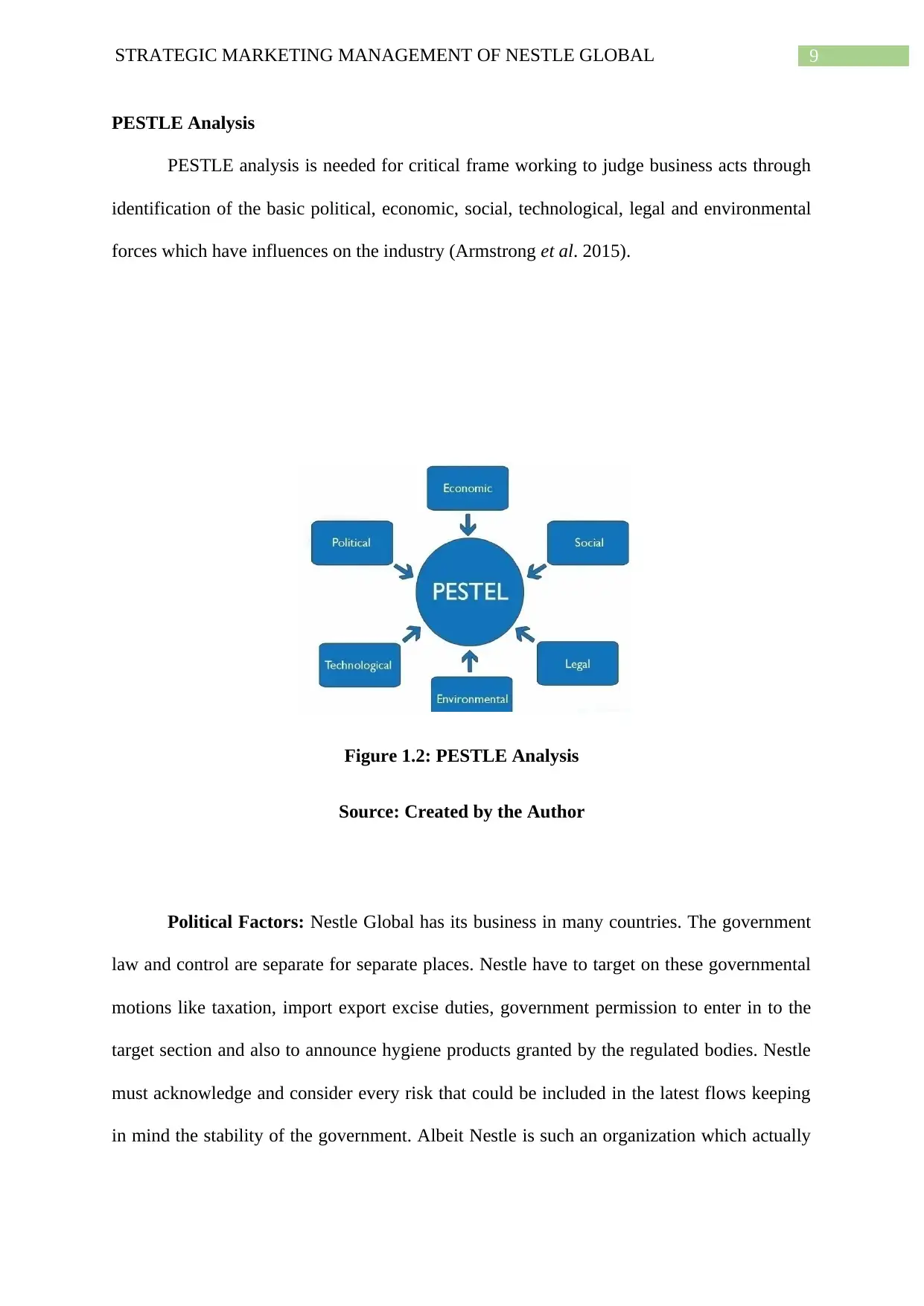
9STRATEGIC MARKETING MANAGEMENT OF NESTLE GLOBAL
PESTLE Analysis
PESTLE analysis is needed for critical frame working to judge business acts through
identification of the basic political, economic, social, technological, legal and environmental
forces which have influences on the industry (Armstrong et al. 2015).
Figure 1.2: PESTLE Analysis
Source: Created by the Author
Political Factors: Nestle Global has its business in many countries. The government
law and control are separate for separate places. Nestle have to target on these governmental
motions like taxation, import export excise duties, government permission to enter in to the
target section and also to announce hygiene products granted by the regulated bodies. Nestle
must acknowledge and consider every risk that could be included in the latest flows keeping
in mind the stability of the government. Albeit Nestle is such an organization which actually
PESTLE Analysis
PESTLE analysis is needed for critical frame working to judge business acts through
identification of the basic political, economic, social, technological, legal and environmental
forces which have influences on the industry (Armstrong et al. 2015).
Figure 1.2: PESTLE Analysis
Source: Created by the Author
Political Factors: Nestle Global has its business in many countries. The government
law and control are separate for separate places. Nestle have to target on these governmental
motions like taxation, import export excise duties, government permission to enter in to the
target section and also to announce hygiene products granted by the regulated bodies. Nestle
must acknowledge and consider every risk that could be included in the latest flows keeping
in mind the stability of the government. Albeit Nestle is such an organization which actually
Secure Best Marks with AI Grader
Need help grading? Try our AI Grader for instant feedback on your assignments.
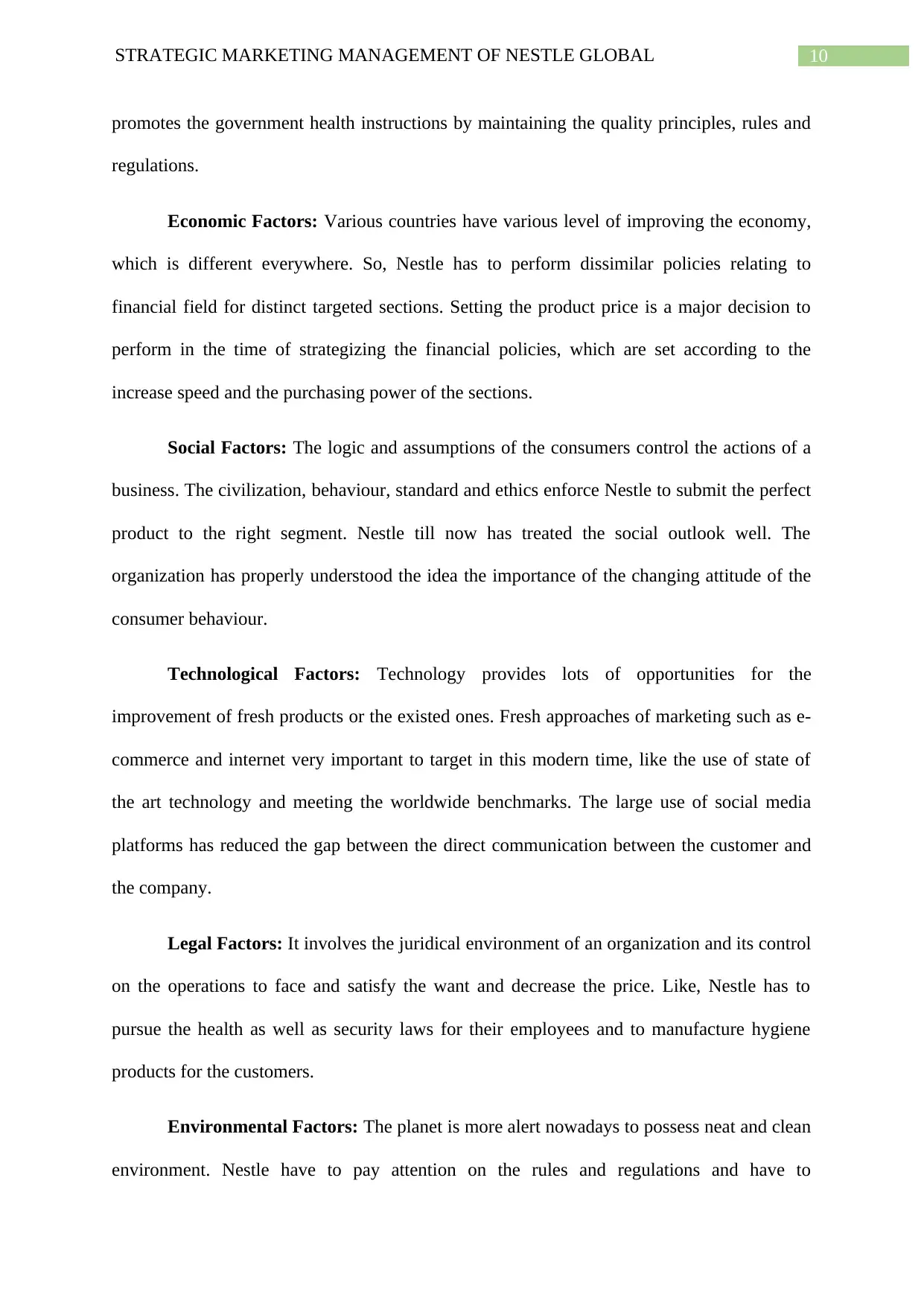
10STRATEGIC MARKETING MANAGEMENT OF NESTLE GLOBAL
promotes the government health instructions by maintaining the quality principles, rules and
regulations.
Economic Factors: Various countries have various level of improving the economy,
which is different everywhere. So, Nestle has to perform dissimilar policies relating to
financial field for distinct targeted sections. Setting the product price is a major decision to
perform in the time of strategizing the financial policies, which are set according to the
increase speed and the purchasing power of the sections.
Social Factors: The logic and assumptions of the consumers control the actions of a
business. The civilization, behaviour, standard and ethics enforce Nestle to submit the perfect
product to the right segment. Nestle till now has treated the social outlook well. The
organization has properly understood the idea the importance of the changing attitude of the
consumer behaviour.
Technological Factors: Technology provides lots of opportunities for the
improvement of fresh products or the existed ones. Fresh approaches of marketing such as e-
commerce and internet very important to target in this modern time, like the use of state of
the art technology and meeting the worldwide benchmarks. The large use of social media
platforms has reduced the gap between the direct communication between the customer and
the company.
Legal Factors: It involves the juridical environment of an organization and its control
on the operations to face and satisfy the want and decrease the price. Like, Nestle has to
pursue the health as well as security laws for their employees and to manufacture hygiene
products for the customers.
Environmental Factors: The planet is more alert nowadays to possess neat and clean
environment. Nestle have to pay attention on the rules and regulations and have to
promotes the government health instructions by maintaining the quality principles, rules and
regulations.
Economic Factors: Various countries have various level of improving the economy,
which is different everywhere. So, Nestle has to perform dissimilar policies relating to
financial field for distinct targeted sections. Setting the product price is a major decision to
perform in the time of strategizing the financial policies, which are set according to the
increase speed and the purchasing power of the sections.
Social Factors: The logic and assumptions of the consumers control the actions of a
business. The civilization, behaviour, standard and ethics enforce Nestle to submit the perfect
product to the right segment. Nestle till now has treated the social outlook well. The
organization has properly understood the idea the importance of the changing attitude of the
consumer behaviour.
Technological Factors: Technology provides lots of opportunities for the
improvement of fresh products or the existed ones. Fresh approaches of marketing such as e-
commerce and internet very important to target in this modern time, like the use of state of
the art technology and meeting the worldwide benchmarks. The large use of social media
platforms has reduced the gap between the direct communication between the customer and
the company.
Legal Factors: It involves the juridical environment of an organization and its control
on the operations to face and satisfy the want and decrease the price. Like, Nestle has to
pursue the health as well as security laws for their employees and to manufacture hygiene
products for the customers.
Environmental Factors: The planet is more alert nowadays to possess neat and clean
environment. Nestle have to pay attention on the rules and regulations and have to
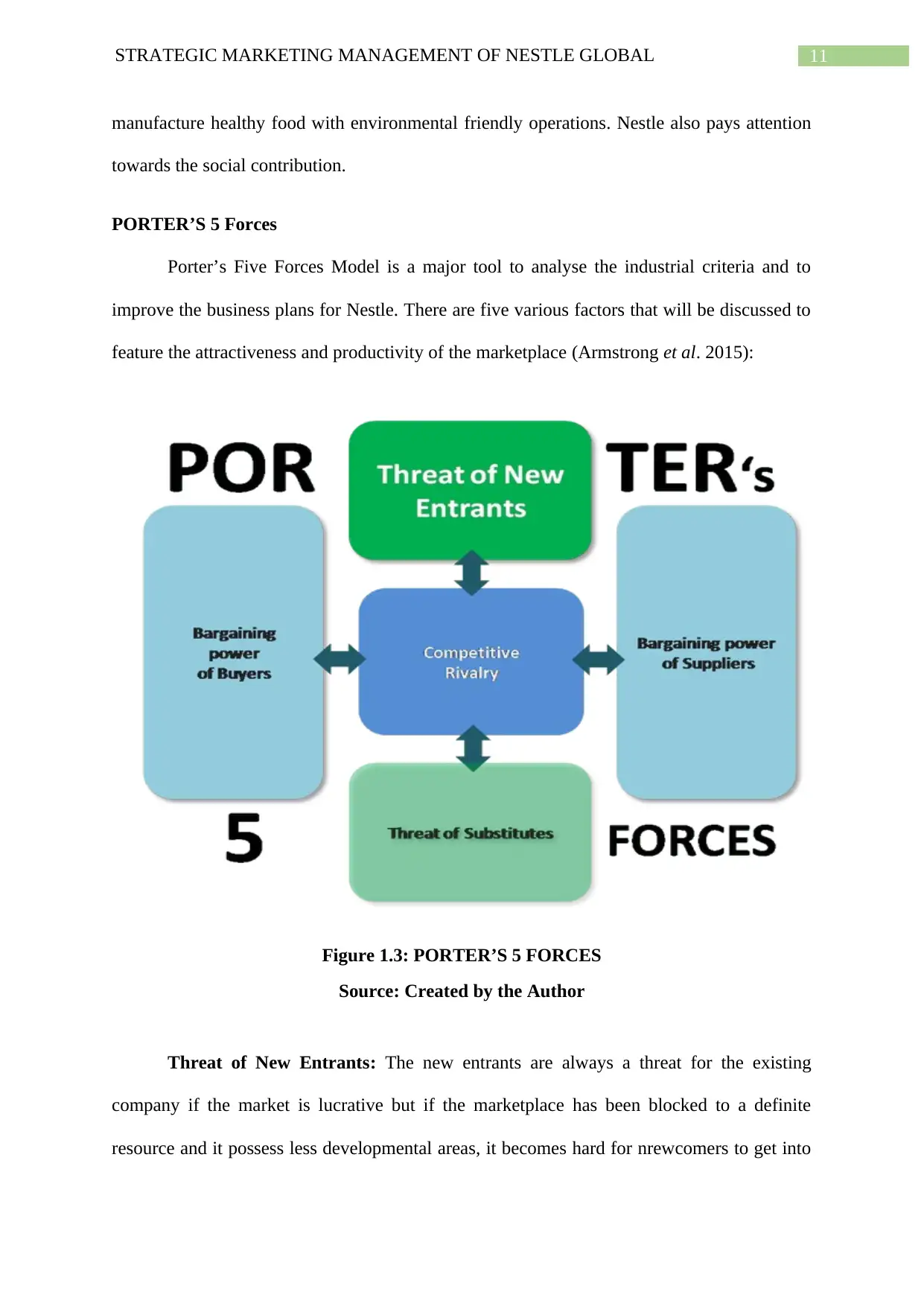
11STRATEGIC MARKETING MANAGEMENT OF NESTLE GLOBAL
manufacture healthy food with environmental friendly operations. Nestle also pays attention
towards the social contribution.
PORTER’S 5 Forces
Porter’s Five Forces Model is a major tool to analyse the industrial criteria and to
improve the business plans for Nestle. There are five various factors that will be discussed to
feature the attractiveness and productivity of the marketplace (Armstrong et al. 2015):
Figure 1.3: PORTER’S 5 FORCES
Source: Created by the Author
Threat of New Entrants: The new entrants are always a threat for the existing
company if the market is lucrative but if the marketplace has been blocked to a definite
resource and it possess less developmental areas, it becomes hard for nrewcomers to get into
manufacture healthy food with environmental friendly operations. Nestle also pays attention
towards the social contribution.
PORTER’S 5 Forces
Porter’s Five Forces Model is a major tool to analyse the industrial criteria and to
improve the business plans for Nestle. There are five various factors that will be discussed to
feature the attractiveness and productivity of the marketplace (Armstrong et al. 2015):
Figure 1.3: PORTER’S 5 FORCES
Source: Created by the Author
Threat of New Entrants: The new entrants are always a threat for the existing
company if the market is lucrative but if the marketplace has been blocked to a definite
resource and it possess less developmental areas, it becomes hard for nrewcomers to get into
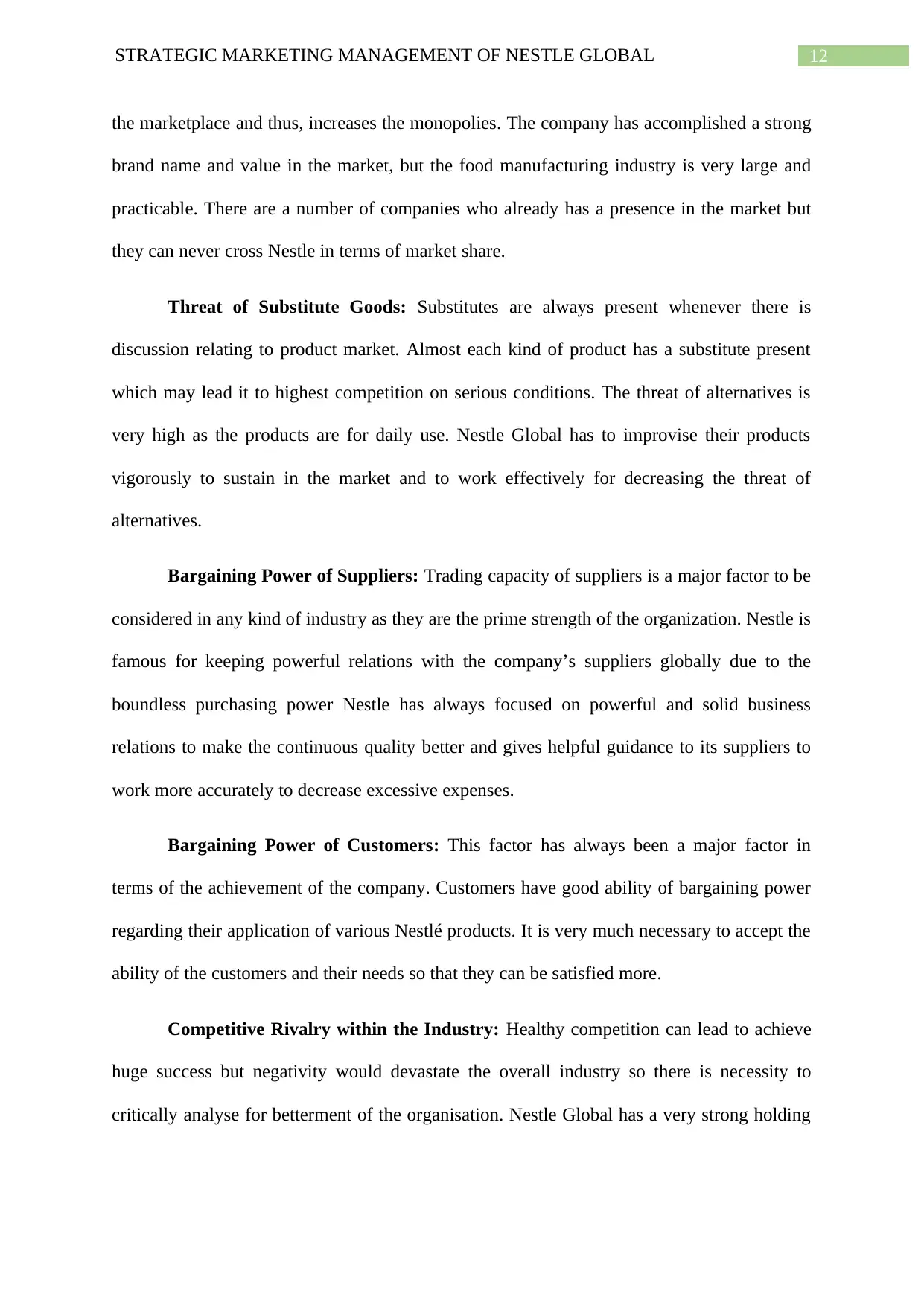
12STRATEGIC MARKETING MANAGEMENT OF NESTLE GLOBAL
the marketplace and thus, increases the monopolies. The company has accomplished a strong
brand name and value in the market, but the food manufacturing industry is very large and
practicable. There are a number of companies who already has a presence in the market but
they can never cross Nestle in terms of market share.
Threat of Substitute Goods: Substitutes are always present whenever there is
discussion relating to product market. Almost each kind of product has a substitute present
which may lead it to highest competition on serious conditions. The threat of alternatives is
very high as the products are for daily use. Nestle Global has to improvise their products
vigorously to sustain in the market and to work effectively for decreasing the threat of
alternatives.
Bargaining Power of Suppliers: Trading capacity of suppliers is a major factor to be
considered in any kind of industry as they are the prime strength of the organization. Nestle is
famous for keeping powerful relations with the company’s suppliers globally due to the
boundless purchasing power Nestle has always focused on powerful and solid business
relations to make the continuous quality better and gives helpful guidance to its suppliers to
work more accurately to decrease excessive expenses.
Bargaining Power of Customers: This factor has always been a major factor in
terms of the achievement of the company. Customers have good ability of bargaining power
regarding their application of various Nestlé products. It is very much necessary to accept the
ability of the customers and their needs so that they can be satisfied more.
Competitive Rivalry within the Industry: Healthy competition can lead to achieve
huge success but negativity would devastate the overall industry so there is necessity to
critically analyse for betterment of the organisation. Nestle Global has a very strong holding
the marketplace and thus, increases the monopolies. The company has accomplished a strong
brand name and value in the market, but the food manufacturing industry is very large and
practicable. There are a number of companies who already has a presence in the market but
they can never cross Nestle in terms of market share.
Threat of Substitute Goods: Substitutes are always present whenever there is
discussion relating to product market. Almost each kind of product has a substitute present
which may lead it to highest competition on serious conditions. The threat of alternatives is
very high as the products are for daily use. Nestle Global has to improvise their products
vigorously to sustain in the market and to work effectively for decreasing the threat of
alternatives.
Bargaining Power of Suppliers: Trading capacity of suppliers is a major factor to be
considered in any kind of industry as they are the prime strength of the organization. Nestle is
famous for keeping powerful relations with the company’s suppliers globally due to the
boundless purchasing power Nestle has always focused on powerful and solid business
relations to make the continuous quality better and gives helpful guidance to its suppliers to
work more accurately to decrease excessive expenses.
Bargaining Power of Customers: This factor has always been a major factor in
terms of the achievement of the company. Customers have good ability of bargaining power
regarding their application of various Nestlé products. It is very much necessary to accept the
ability of the customers and their needs so that they can be satisfied more.
Competitive Rivalry within the Industry: Healthy competition can lead to achieve
huge success but negativity would devastate the overall industry so there is necessity to
critically analyse for betterment of the organisation. Nestle Global has a very strong holding
Paraphrase This Document
Need a fresh take? Get an instant paraphrase of this document with our AI Paraphraser
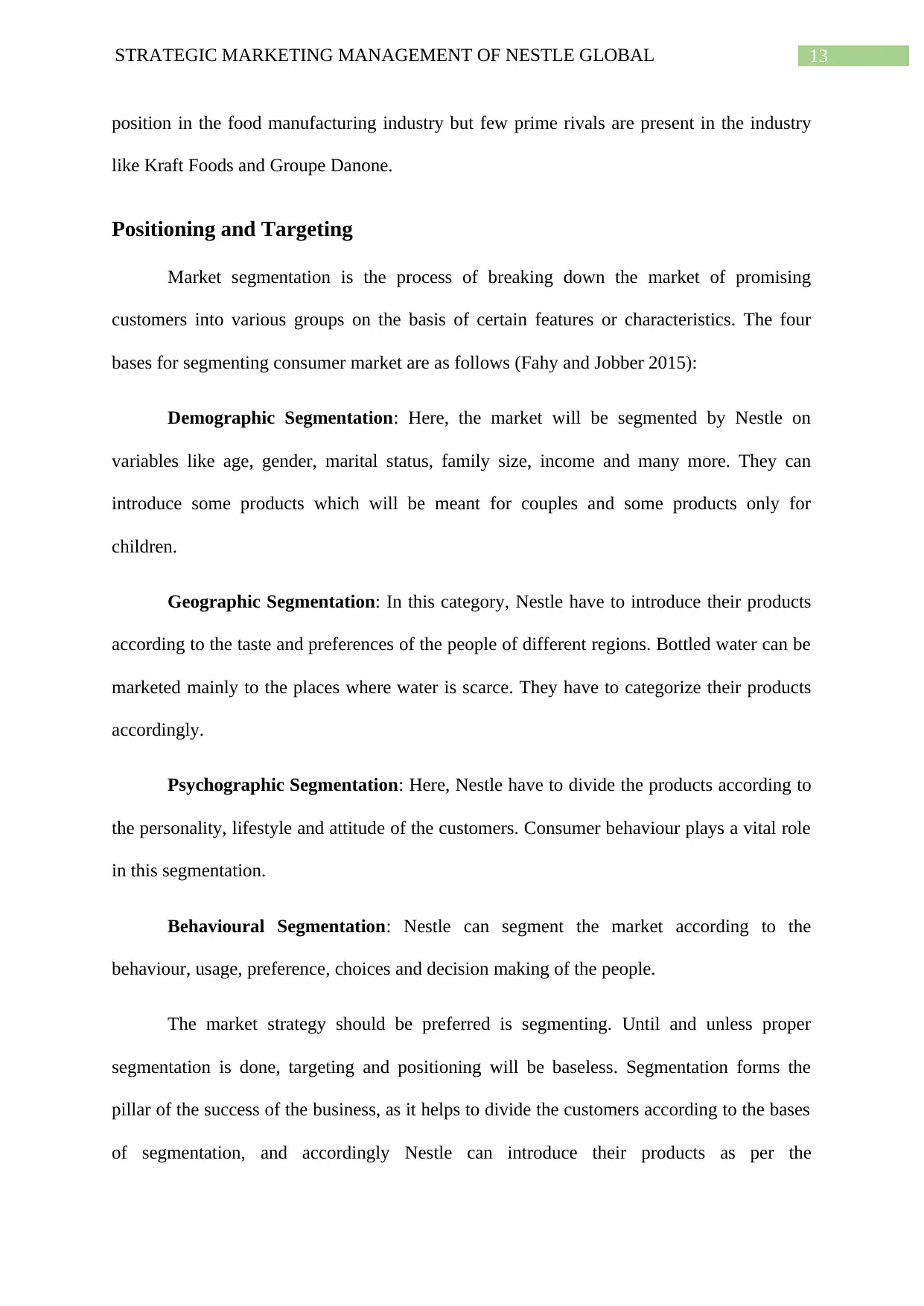
13STRATEGIC MARKETING MANAGEMENT OF NESTLE GLOBAL
position in the food manufacturing industry but few prime rivals are present in the industry
like Kraft Foods and Groupe Danone.
Positioning and Targeting
Market segmentation is the process of breaking down the market of promising
customers into various groups on the basis of certain features or characteristics. The four
bases for segmenting consumer market are as follows (Fahy and Jobber 2015):
Demographic Segmentation: Here, the market will be segmented by Nestle on
variables like age, gender, marital status, family size, income and many more. They can
introduce some products which will be meant for couples and some products only for
children.
Geographic Segmentation: In this category, Nestle have to introduce their products
according to the taste and preferences of the people of different regions. Bottled water can be
marketed mainly to the places where water is scarce. They have to categorize their products
accordingly.
Psychographic Segmentation: Here, Nestle have to divide the products according to
the personality, lifestyle and attitude of the customers. Consumer behaviour plays a vital role
in this segmentation.
Behavioural Segmentation: Nestle can segment the market according to the
behaviour, usage, preference, choices and decision making of the people.
The market strategy should be preferred is segmenting. Until and unless proper
segmentation is done, targeting and positioning will be baseless. Segmentation forms the
pillar of the success of the business, as it helps to divide the customers according to the bases
of segmentation, and accordingly Nestle can introduce their products as per the
position in the food manufacturing industry but few prime rivals are present in the industry
like Kraft Foods and Groupe Danone.
Positioning and Targeting
Market segmentation is the process of breaking down the market of promising
customers into various groups on the basis of certain features or characteristics. The four
bases for segmenting consumer market are as follows (Fahy and Jobber 2015):
Demographic Segmentation: Here, the market will be segmented by Nestle on
variables like age, gender, marital status, family size, income and many more. They can
introduce some products which will be meant for couples and some products only for
children.
Geographic Segmentation: In this category, Nestle have to introduce their products
according to the taste and preferences of the people of different regions. Bottled water can be
marketed mainly to the places where water is scarce. They have to categorize their products
accordingly.
Psychographic Segmentation: Here, Nestle have to divide the products according to
the personality, lifestyle and attitude of the customers. Consumer behaviour plays a vital role
in this segmentation.
Behavioural Segmentation: Nestle can segment the market according to the
behaviour, usage, preference, choices and decision making of the people.
The market strategy should be preferred is segmenting. Until and unless proper
segmentation is done, targeting and positioning will be baseless. Segmentation forms the
pillar of the success of the business, as it helps to divide the customers according to the bases
of segmentation, and accordingly Nestle can introduce their products as per the
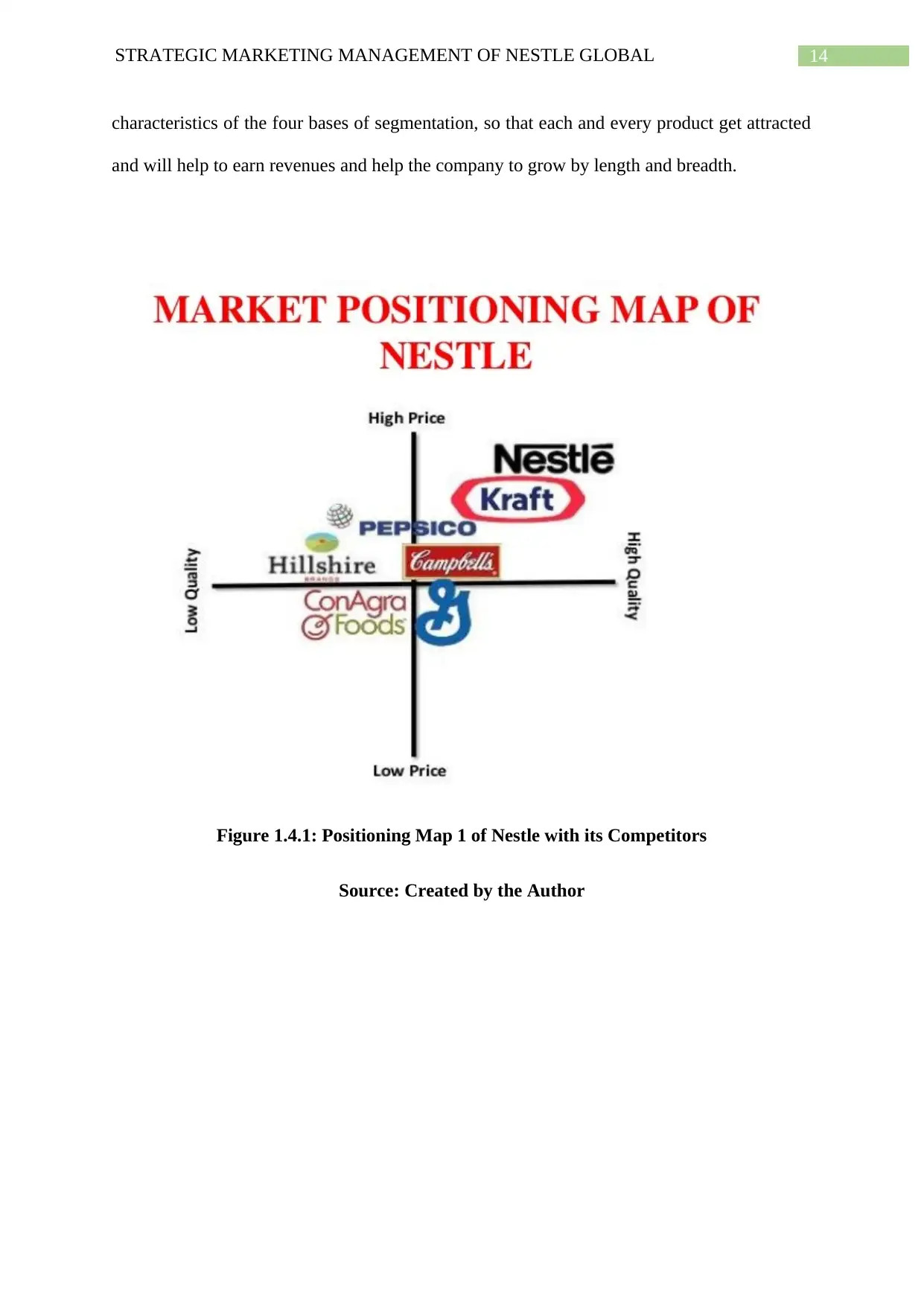
14STRATEGIC MARKETING MANAGEMENT OF NESTLE GLOBAL
characteristics of the four bases of segmentation, so that each and every product get attracted
and will help to earn revenues and help the company to grow by length and breadth.
Figure 1.4.1: Positioning Map 1 of Nestle with its Competitors
Source: Created by the Author
characteristics of the four bases of segmentation, so that each and every product get attracted
and will help to earn revenues and help the company to grow by length and breadth.
Figure 1.4.1: Positioning Map 1 of Nestle with its Competitors
Source: Created by the Author
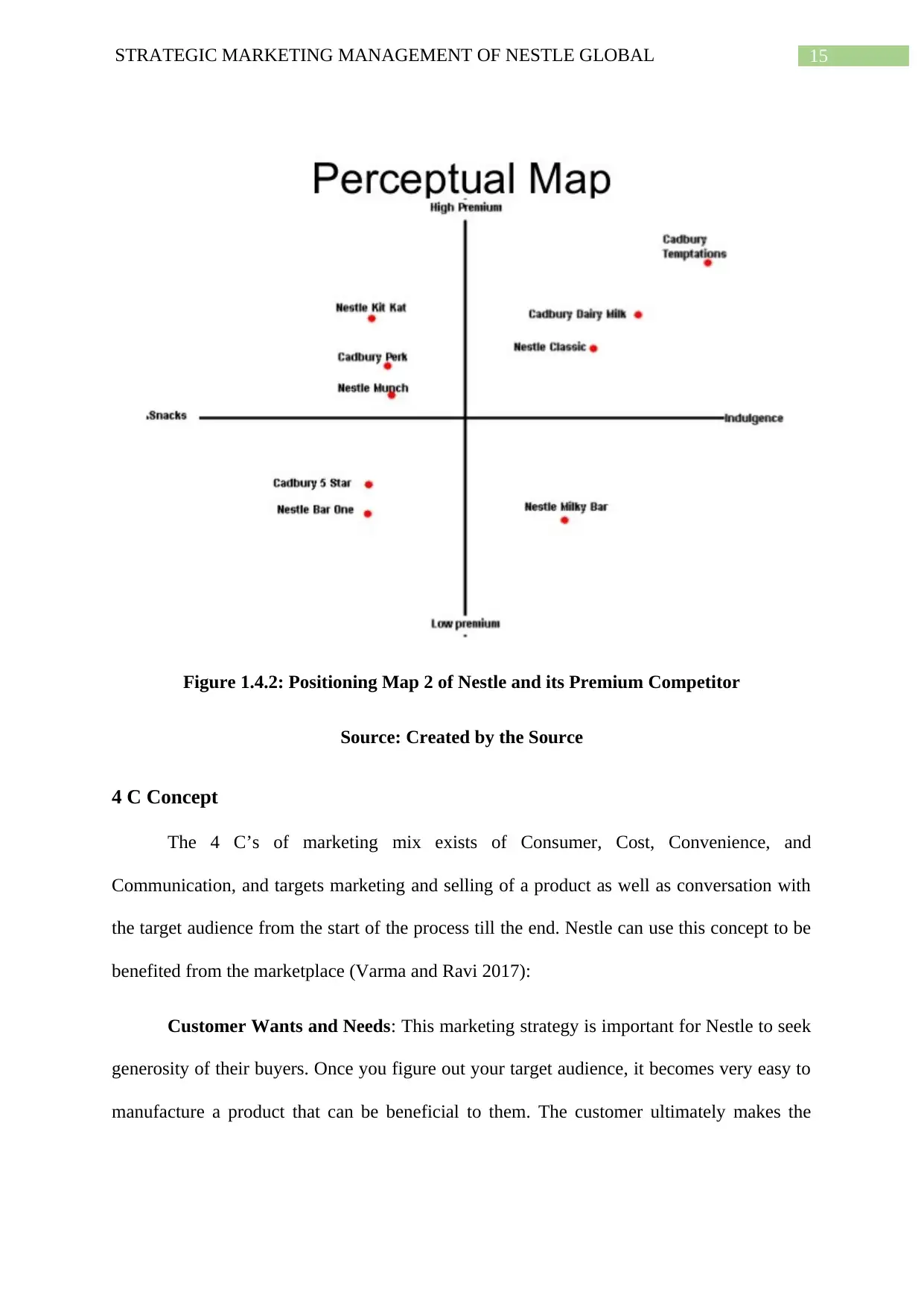
15STRATEGIC MARKETING MANAGEMENT OF NESTLE GLOBAL
Figure 1.4.2: Positioning Map 2 of Nestle and its Premium Competitor
Source: Created by the Source
4 C Concept
The 4 C’s of marketing mix exists of Consumer, Cost, Convenience, and
Communication, and targets marketing and selling of a product as well as conversation with
the target audience from the start of the process till the end. Nestle can use this concept to be
benefited from the marketplace (Varma and Ravi 2017):
Customer Wants and Needs: This marketing strategy is important for Nestle to seek
generosity of their buyers. Once you figure out your target audience, it becomes very easy to
manufacture a product that can be beneficial to them. The customer ultimately makes the
Figure 1.4.2: Positioning Map 2 of Nestle and its Premium Competitor
Source: Created by the Source
4 C Concept
The 4 C’s of marketing mix exists of Consumer, Cost, Convenience, and
Communication, and targets marketing and selling of a product as well as conversation with
the target audience from the start of the process till the end. Nestle can use this concept to be
benefited from the marketplace (Varma and Ravi 2017):
Customer Wants and Needs: This marketing strategy is important for Nestle to seek
generosity of their buyers. Once you figure out your target audience, it becomes very easy to
manufacture a product that can be beneficial to them. The customer ultimately makes the
Secure Best Marks with AI Grader
Need help grading? Try our AI Grader for instant feedback on your assignments.
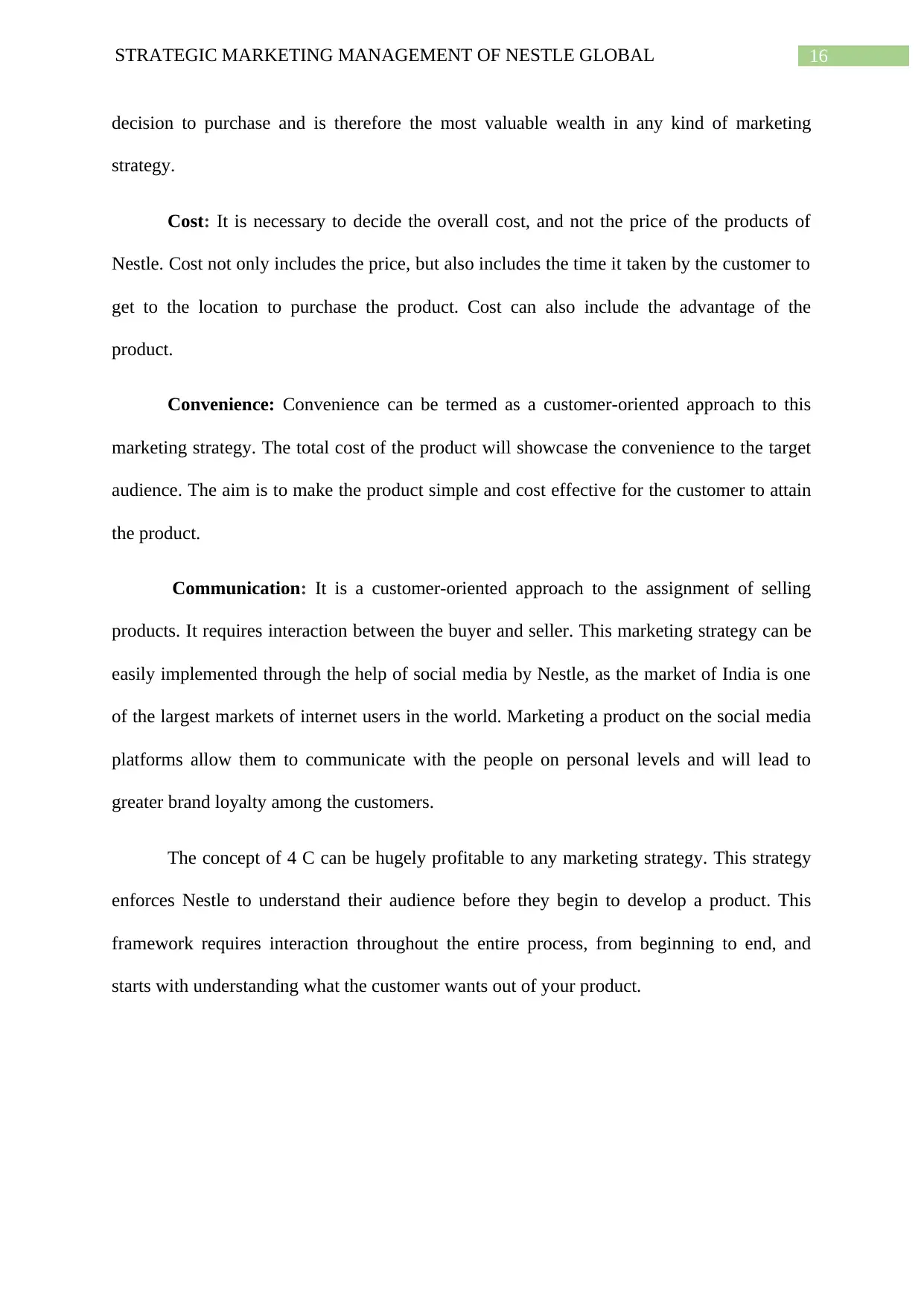
16STRATEGIC MARKETING MANAGEMENT OF NESTLE GLOBAL
decision to purchase and is therefore the most valuable wealth in any kind of marketing
strategy.
Cost: It is necessary to decide the overall cost, and not the price of the products of
Nestle. Cost not only includes the price, but also includes the time it taken by the customer to
get to the location to purchase the product. Cost can also include the advantage of the
product.
Convenience: Convenience can be termed as a customer-oriented approach to this
marketing strategy. The total cost of the product will showcase the convenience to the target
audience. The aim is to make the product simple and cost effective for the customer to attain
the product.
Communication: It is a customer-oriented approach to the assignment of selling
products. It requires interaction between the buyer and seller. This marketing strategy can be
easily implemented through the help of social media by Nestle, as the market of India is one
of the largest markets of internet users in the world. Marketing a product on the social media
platforms allow them to communicate with the people on personal levels and will lead to
greater brand loyalty among the customers.
The concept of 4 C can be hugely profitable to any marketing strategy. This strategy
enforces Nestle to understand their audience before they begin to develop a product. This
framework requires interaction throughout the entire process, from beginning to end, and
starts with understanding what the customer wants out of your product.
decision to purchase and is therefore the most valuable wealth in any kind of marketing
strategy.
Cost: It is necessary to decide the overall cost, and not the price of the products of
Nestle. Cost not only includes the price, but also includes the time it taken by the customer to
get to the location to purchase the product. Cost can also include the advantage of the
product.
Convenience: Convenience can be termed as a customer-oriented approach to this
marketing strategy. The total cost of the product will showcase the convenience to the target
audience. The aim is to make the product simple and cost effective for the customer to attain
the product.
Communication: It is a customer-oriented approach to the assignment of selling
products. It requires interaction between the buyer and seller. This marketing strategy can be
easily implemented through the help of social media by Nestle, as the market of India is one
of the largest markets of internet users in the world. Marketing a product on the social media
platforms allow them to communicate with the people on personal levels and will lead to
greater brand loyalty among the customers.
The concept of 4 C can be hugely profitable to any marketing strategy. This strategy
enforces Nestle to understand their audience before they begin to develop a product. This
framework requires interaction throughout the entire process, from beginning to end, and
starts with understanding what the customer wants out of your product.
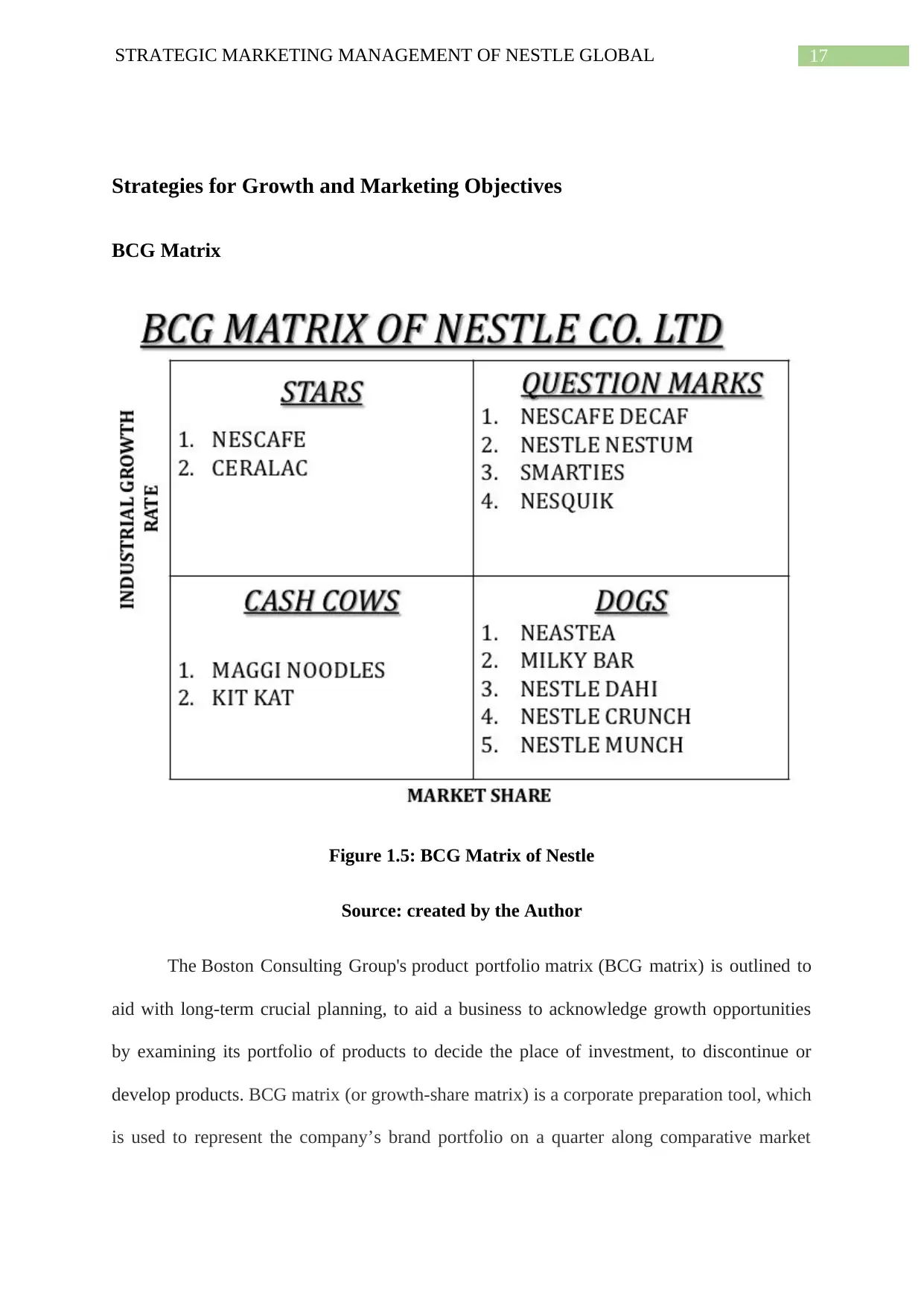
17STRATEGIC MARKETING MANAGEMENT OF NESTLE GLOBAL
Strategies for Growth and Marketing Objectives
BCG Matrix
Figure 1.5: BCG Matrix of Nestle
Source: created by the Author
The Boston Consulting Group's product portfolio matrix (BCG matrix) is outlined to
aid with long-term crucial planning, to aid a business to acknowledge growth opportunities
by examining its portfolio of products to decide the place of investment, to discontinue or
develop products. BCG matrix (or growth-share matrix) is a corporate preparation tool, which
is used to represent the company’s brand portfolio on a quarter along comparative market
Strategies for Growth and Marketing Objectives
BCG Matrix
Figure 1.5: BCG Matrix of Nestle
Source: created by the Author
The Boston Consulting Group's product portfolio matrix (BCG matrix) is outlined to
aid with long-term crucial planning, to aid a business to acknowledge growth opportunities
by examining its portfolio of products to decide the place of investment, to discontinue or
develop products. BCG matrix (or growth-share matrix) is a corporate preparation tool, which
is used to represent the company’s brand portfolio on a quarter along comparative market
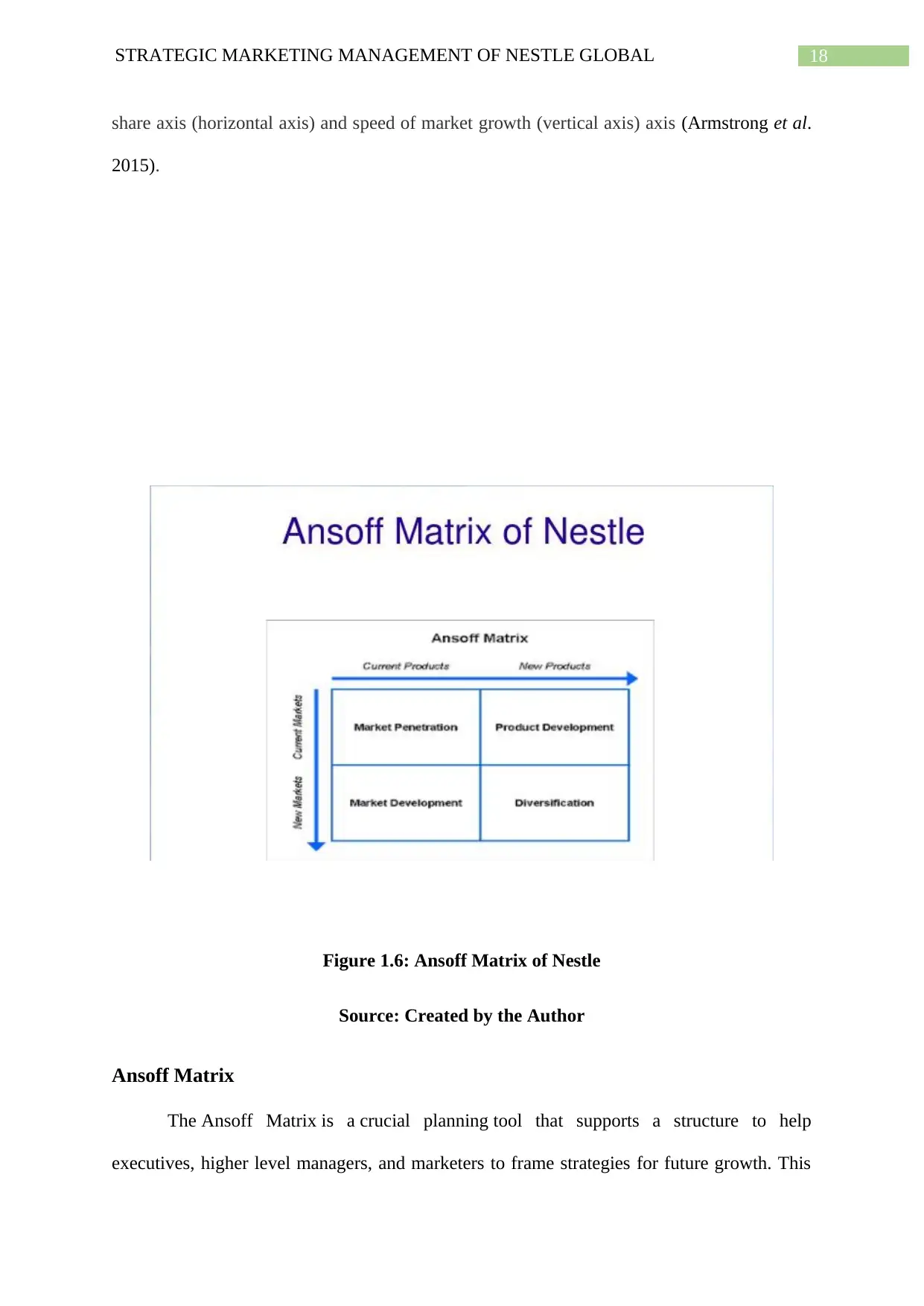
18STRATEGIC MARKETING MANAGEMENT OF NESTLE GLOBAL
share axis (horizontal axis) and speed of market growth (vertical axis) axis (Armstrong et al.
2015).
Figure 1.6: Ansoff Matrix of Nestle
Source: Created by the Author
Ansoff Matrix
The Ansoff Matrix is a crucial planning tool that supports a structure to help
executives, higher level managers, and marketers to frame strategies for future growth. This
share axis (horizontal axis) and speed of market growth (vertical axis) axis (Armstrong et al.
2015).
Figure 1.6: Ansoff Matrix of Nestle
Source: Created by the Author
Ansoff Matrix
The Ansoff Matrix is a crucial planning tool that supports a structure to help
executives, higher level managers, and marketers to frame strategies for future growth. This
Paraphrase This Document
Need a fresh take? Get an instant paraphrase of this document with our AI Paraphraser
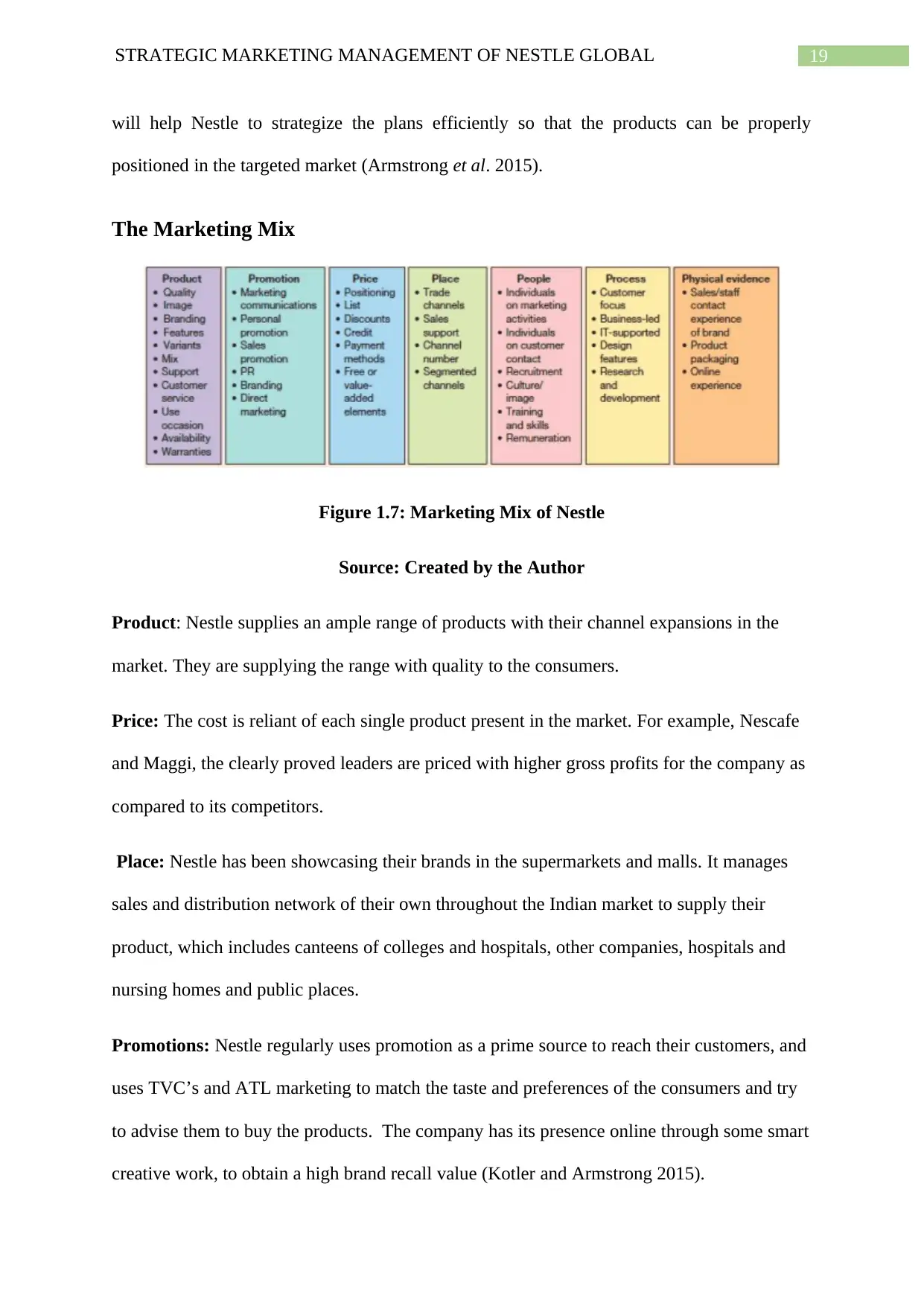
19STRATEGIC MARKETING MANAGEMENT OF NESTLE GLOBAL
will help Nestle to strategize the plans efficiently so that the products can be properly
positioned in the targeted market (Armstrong et al. 2015).
The Marketing Mix
Figure 1.7: Marketing Mix of Nestle
Source: Created by the Author
Product: Nestle supplies an ample range of products with their channel expansions in the
market. They are supplying the range with quality to the consumers.
Price: The cost is reliant of each single product present in the market. For example, Nescafe
and Maggi, the clearly proved leaders are priced with higher gross profits for the company as
compared to its competitors.
Place: Nestle has been showcasing their brands in the supermarkets and malls. It manages
sales and distribution network of their own throughout the Indian market to supply their
product, which includes canteens of colleges and hospitals, other companies, hospitals and
nursing homes and public places.
Promotions: Nestle regularly uses promotion as a prime source to reach their customers, and
uses TVC’s and ATL marketing to match the taste and preferences of the consumers and try
to advise them to buy the products. The company has its presence online through some smart
creative work, to obtain a high brand recall value (Kotler and Armstrong 2015).
will help Nestle to strategize the plans efficiently so that the products can be properly
positioned in the targeted market (Armstrong et al. 2015).
The Marketing Mix
Figure 1.7: Marketing Mix of Nestle
Source: Created by the Author
Product: Nestle supplies an ample range of products with their channel expansions in the
market. They are supplying the range with quality to the consumers.
Price: The cost is reliant of each single product present in the market. For example, Nescafe
and Maggi, the clearly proved leaders are priced with higher gross profits for the company as
compared to its competitors.
Place: Nestle has been showcasing their brands in the supermarkets and malls. It manages
sales and distribution network of their own throughout the Indian market to supply their
product, which includes canteens of colleges and hospitals, other companies, hospitals and
nursing homes and public places.
Promotions: Nestle regularly uses promotion as a prime source to reach their customers, and
uses TVC’s and ATL marketing to match the taste and preferences of the consumers and try
to advise them to buy the products. The company has its presence online through some smart
creative work, to obtain a high brand recall value (Kotler and Armstrong 2015).
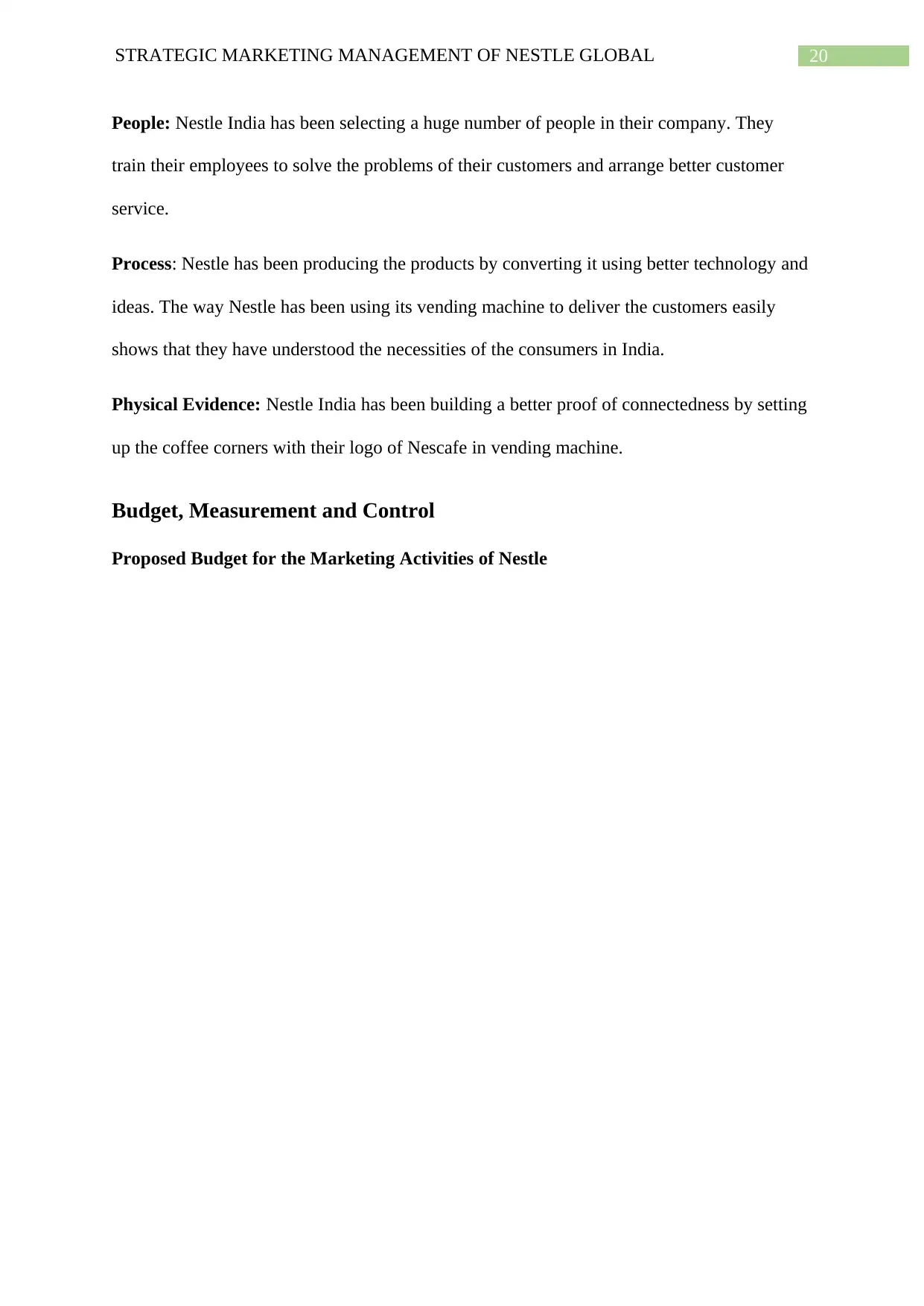
20STRATEGIC MARKETING MANAGEMENT OF NESTLE GLOBAL
People: Nestle India has been selecting a huge number of people in their company. They
train their employees to solve the problems of their customers and arrange better customer
service.
Process: Nestle has been producing the products by converting it using better technology and
ideas. The way Nestle has been using its vending machine to deliver the customers easily
shows that they have understood the necessities of the consumers in India.
Physical Evidence: Nestle India has been building a better proof of connectedness by setting
up the coffee corners with their logo of Nescafe in vending machine.
Budget, Measurement and Control
Proposed Budget for the Marketing Activities of Nestle
People: Nestle India has been selecting a huge number of people in their company. They
train their employees to solve the problems of their customers and arrange better customer
service.
Process: Nestle has been producing the products by converting it using better technology and
ideas. The way Nestle has been using its vending machine to deliver the customers easily
shows that they have understood the necessities of the consumers in India.
Physical Evidence: Nestle India has been building a better proof of connectedness by setting
up the coffee corners with their logo of Nescafe in vending machine.
Budget, Measurement and Control
Proposed Budget for the Marketing Activities of Nestle
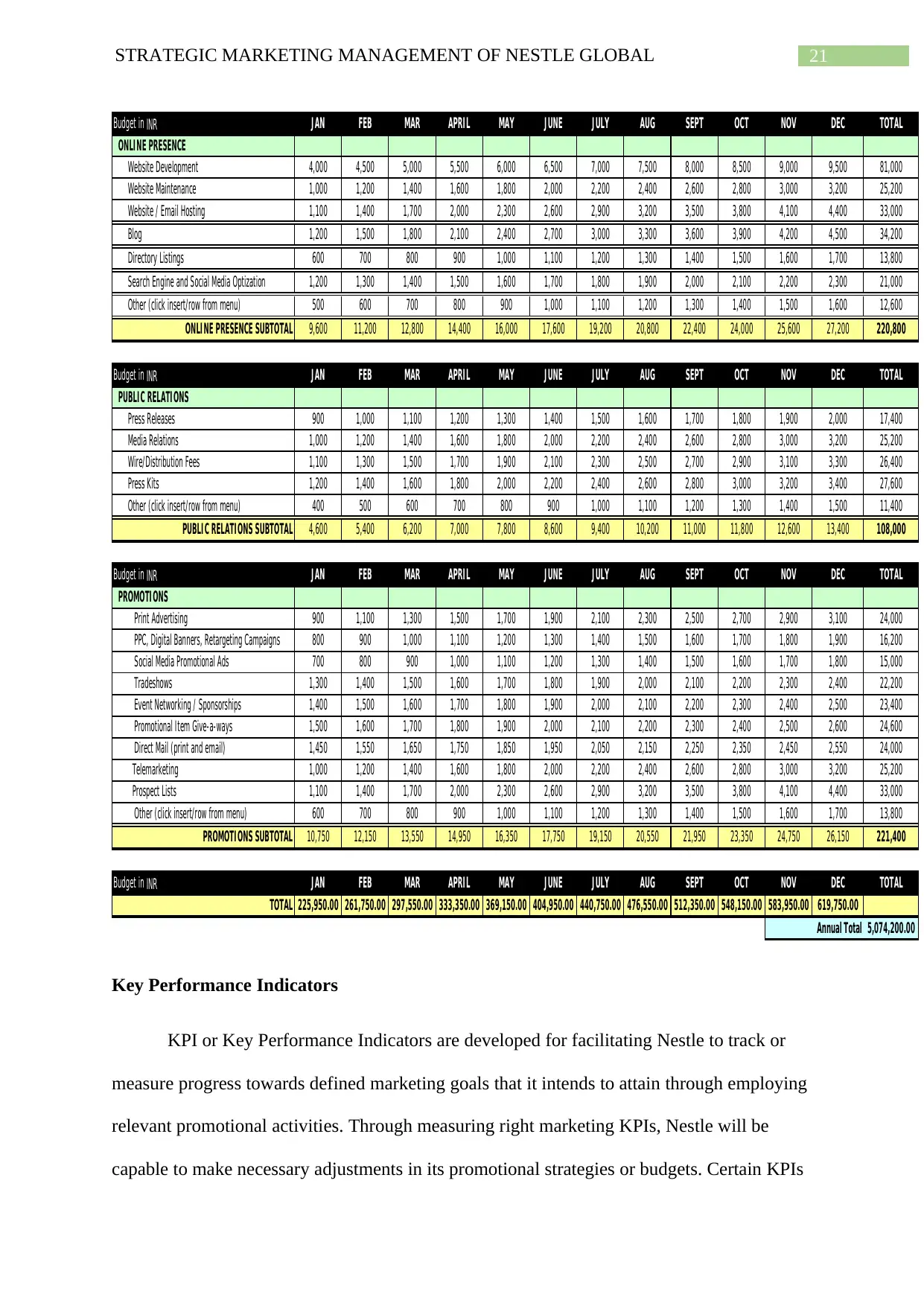
21STRATEGIC MARKETING MANAGEMENT OF NESTLE GLOBAL
Budget in INR J AN FEB MAR APRI L MAY J UNE J ULY AUG SEPT OCT NOV DEC TOTAL
ONLI NE PRESENCE
Website Development 4,000 4,500 5,000 5,500 6,000 6,500 7,000 7,500 8,000 8,500 9,000 9,500 81,000
Website Maintenance 1,000 1,200 1,400 1,600 1,800 2,000 2,200 2,400 2,600 2,800 3,000 3,200 25,200
Website / Email Hosting 1,100 1,400 1,700 2,000 2,300 2,600 2,900 3,200 3,500 3,800 4,100 4,400 33,000
Blog 1,200 1,500 1,800 2,100 2,400 2,700 3,000 3,300 3,600 3,900 4,200 4,500 34,200
Directory Listings 600 700 800 900 1,000 1,100 1,200 1,300 1,400 1,500 1,600 1,700 13,800
Search Engine and Social Media Optization 1,200 1,300 1,400 1,500 1,600 1,700 1,800 1,900 2,000 2,100 2,200 2,300 21,000
Other (click insert/row from menu) 500 600 700 800 900 1,000 1,100 1,200 1,300 1,400 1,500 1,600 12,600
ONLI NE PRESENCE SUBTOTAL 9,600 11,200 12,800 14,400 16,000 17,600 19,200 20,800 22,400 24,000 25,600 27,200 220,800
Budget in INR J AN FEB MAR APRI L MAY J UNE J ULY AUG SEPT OCT NOV DEC TOTAL
PUBLI C RELATI ONS
Press Releases 900 1,000 1,100 1,200 1,300 1,400 1,500 1,600 1,700 1,800 1,900 2,000 17,400
Media Relations 1,000 1,200 1,400 1,600 1,800 2,000 2,200 2,400 2,600 2,800 3,000 3,200 25,200
Wire/ Distribution Fees 1,100 1,300 1,500 1,700 1,900 2,100 2,300 2,500 2,700 2,900 3,100 3,300 26,400
Press Kits 1,200 1,400 1,600 1,800 2,000 2,200 2,400 2,600 2,800 3,000 3,200 3,400 27,600
Other (click insert/row from menu) 400 500 600 700 800 900 1,000 1,100 1,200 1,300 1,400 1,500 11,400
PUBLI C RELATI ONS SUBTOTAL 4,600 5,400 6,200 7,000 7,800 8,600 9,400 10,200 11,000 11,800 12,600 13,400 108,000
Budget in INR J AN FEB MAR APRI L MAY J UNE J ULY AUG SEPT OCT NOV DEC TOTAL
PROMOTI ONS
Print Advertising 900 1,100 1,300 1,500 1,700 1,900 2,100 2,300 2,500 2,700 2,900 3,100 24,000
PPC, Digital Banners, Retargeting Campaigns 800 900 1,000 1,100 1,200 1,300 1,400 1,500 1,600 1,700 1,800 1,900 16,200
Social Media Promotional Ads 700 800 900 1,000 1,100 1,200 1,300 1,400 1,500 1,600 1,700 1,800 15,000
Tradeshows 1,300 1,400 1,500 1,600 1,700 1,800 1,900 2,000 2,100 2,200 2,300 2,400 22,200
Event Networking / Sponsorships 1,400 1,500 1,600 1,700 1,800 1,900 2,000 2,100 2,200 2,300 2,400 2,500 23,400
Promotional I tem Give- a- ways 1,500 1,600 1,700 1,800 1,900 2,000 2,100 2,200 2,300 2,400 2,500 2,600 24,600
Direct Mail (print and email) 1,450 1,550 1,650 1,750 1,850 1,950 2,050 2,150 2,250 2,350 2,450 2,550 24,000
Telemarketing 1,000 1,200 1,400 1,600 1,800 2,000 2,200 2,400 2,600 2,800 3,000 3,200 25,200
Prospect Lists 1,100 1,400 1,700 2,000 2,300 2,600 2,900 3,200 3,500 3,800 4,100 4,400 33,000
Other (click insert/row from menu) 600 700 800 900 1,000 1,100 1,200 1,300 1,400 1,500 1,600 1,700 13,800
PROMOTI ONS SUBTOTAL 10,750 12,150 13,550 14,950 16,350 17,750 19,150 20,550 21,950 23,350 24,750 26,150 221,400
Budget in INR J AN FEB MAR APRI L MAY J UNE J ULY AUG SEPT OCT NOV DEC TOTAL
TOTAL 225,950.00 261,750.00 297,550.00 333,350.00 369,150.00 404,950.00 440,750.00 476,550.00 512,350.00 548,150.00 583,950.00 619,750.00
Annual Total 5,074,200.00
Key Performance Indicators
KPI or Key Performance Indicators are developed for facilitating Nestle to track or
measure progress towards defined marketing goals that it intends to attain through employing
relevant promotional activities. Through measuring right marketing KPIs, Nestle will be
capable to make necessary adjustments in its promotional strategies or budgets. Certain KPIs
Budget in INR J AN FEB MAR APRI L MAY J UNE J ULY AUG SEPT OCT NOV DEC TOTAL
ONLI NE PRESENCE
Website Development 4,000 4,500 5,000 5,500 6,000 6,500 7,000 7,500 8,000 8,500 9,000 9,500 81,000
Website Maintenance 1,000 1,200 1,400 1,600 1,800 2,000 2,200 2,400 2,600 2,800 3,000 3,200 25,200
Website / Email Hosting 1,100 1,400 1,700 2,000 2,300 2,600 2,900 3,200 3,500 3,800 4,100 4,400 33,000
Blog 1,200 1,500 1,800 2,100 2,400 2,700 3,000 3,300 3,600 3,900 4,200 4,500 34,200
Directory Listings 600 700 800 900 1,000 1,100 1,200 1,300 1,400 1,500 1,600 1,700 13,800
Search Engine and Social Media Optization 1,200 1,300 1,400 1,500 1,600 1,700 1,800 1,900 2,000 2,100 2,200 2,300 21,000
Other (click insert/row from menu) 500 600 700 800 900 1,000 1,100 1,200 1,300 1,400 1,500 1,600 12,600
ONLI NE PRESENCE SUBTOTAL 9,600 11,200 12,800 14,400 16,000 17,600 19,200 20,800 22,400 24,000 25,600 27,200 220,800
Budget in INR J AN FEB MAR APRI L MAY J UNE J ULY AUG SEPT OCT NOV DEC TOTAL
PUBLI C RELATI ONS
Press Releases 900 1,000 1,100 1,200 1,300 1,400 1,500 1,600 1,700 1,800 1,900 2,000 17,400
Media Relations 1,000 1,200 1,400 1,600 1,800 2,000 2,200 2,400 2,600 2,800 3,000 3,200 25,200
Wire/ Distribution Fees 1,100 1,300 1,500 1,700 1,900 2,100 2,300 2,500 2,700 2,900 3,100 3,300 26,400
Press Kits 1,200 1,400 1,600 1,800 2,000 2,200 2,400 2,600 2,800 3,000 3,200 3,400 27,600
Other (click insert/row from menu) 400 500 600 700 800 900 1,000 1,100 1,200 1,300 1,400 1,500 11,400
PUBLI C RELATI ONS SUBTOTAL 4,600 5,400 6,200 7,000 7,800 8,600 9,400 10,200 11,000 11,800 12,600 13,400 108,000
Budget in INR J AN FEB MAR APRI L MAY J UNE J ULY AUG SEPT OCT NOV DEC TOTAL
PROMOTI ONS
Print Advertising 900 1,100 1,300 1,500 1,700 1,900 2,100 2,300 2,500 2,700 2,900 3,100 24,000
PPC, Digital Banners, Retargeting Campaigns 800 900 1,000 1,100 1,200 1,300 1,400 1,500 1,600 1,700 1,800 1,900 16,200
Social Media Promotional Ads 700 800 900 1,000 1,100 1,200 1,300 1,400 1,500 1,600 1,700 1,800 15,000
Tradeshows 1,300 1,400 1,500 1,600 1,700 1,800 1,900 2,000 2,100 2,200 2,300 2,400 22,200
Event Networking / Sponsorships 1,400 1,500 1,600 1,700 1,800 1,900 2,000 2,100 2,200 2,300 2,400 2,500 23,400
Promotional I tem Give- a- ways 1,500 1,600 1,700 1,800 1,900 2,000 2,100 2,200 2,300 2,400 2,500 2,600 24,600
Direct Mail (print and email) 1,450 1,550 1,650 1,750 1,850 1,950 2,050 2,150 2,250 2,350 2,450 2,550 24,000
Telemarketing 1,000 1,200 1,400 1,600 1,800 2,000 2,200 2,400 2,600 2,800 3,000 3,200 25,200
Prospect Lists 1,100 1,400 1,700 2,000 2,300 2,600 2,900 3,200 3,500 3,800 4,100 4,400 33,000
Other (click insert/row from menu) 600 700 800 900 1,000 1,100 1,200 1,300 1,400 1,500 1,600 1,700 13,800
PROMOTI ONS SUBTOTAL 10,750 12,150 13,550 14,950 16,350 17,750 19,150 20,550 21,950 23,350 24,750 26,150 221,400
Budget in INR J AN FEB MAR APRI L MAY J UNE J ULY AUG SEPT OCT NOV DEC TOTAL
TOTAL 225,950.00 261,750.00 297,550.00 333,350.00 369,150.00 404,950.00 440,750.00 476,550.00 512,350.00 548,150.00 583,950.00 619,750.00
Annual Total 5,074,200.00
Key Performance Indicators
KPI or Key Performance Indicators are developed for facilitating Nestle to track or
measure progress towards defined marketing goals that it intends to attain through employing
relevant promotional activities. Through measuring right marketing KPIs, Nestle will be
capable to make necessary adjustments in its promotional strategies or budgets. Certain KPIs
Secure Best Marks with AI Grader
Need help grading? Try our AI Grader for instant feedback on your assignments.
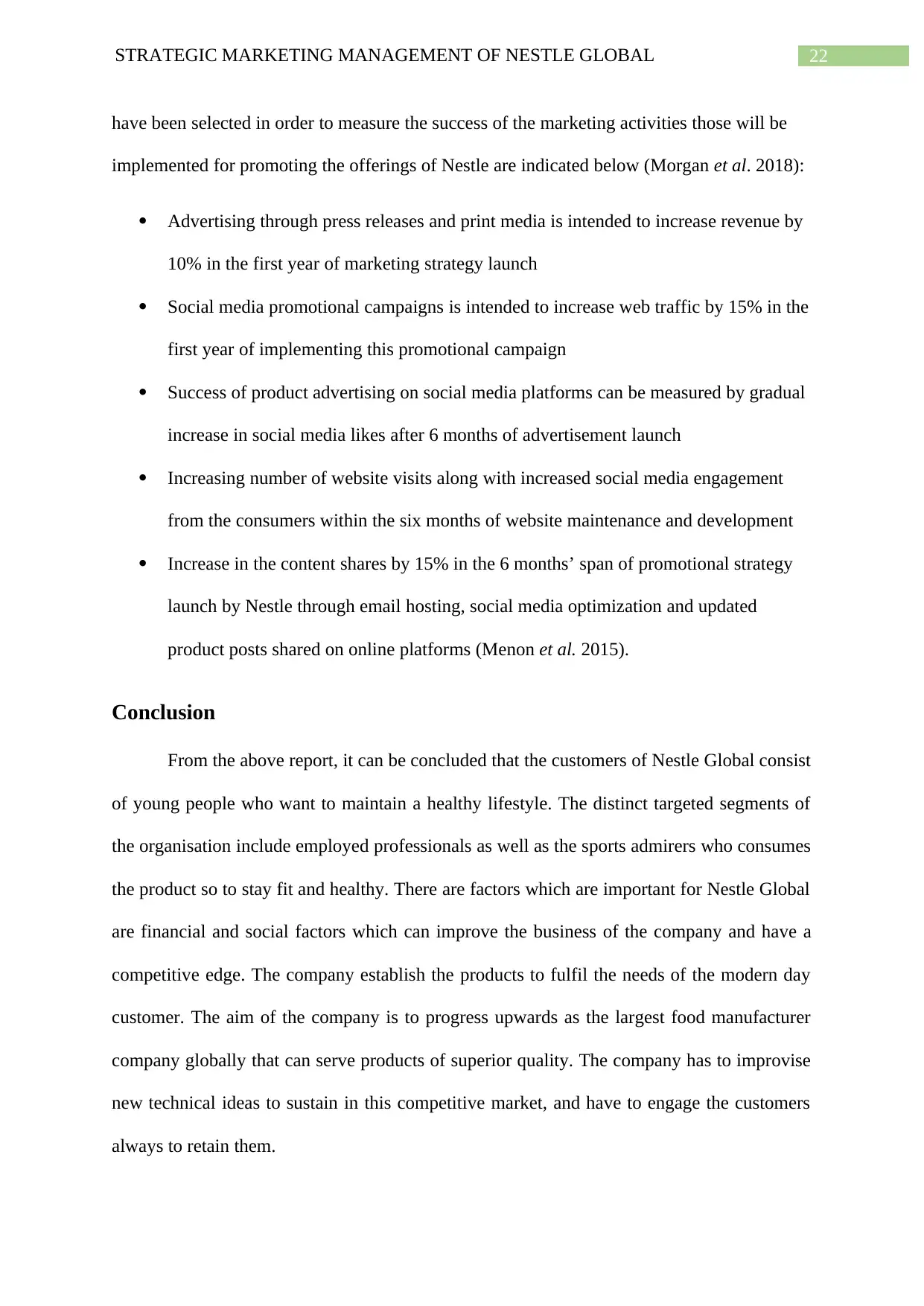
22STRATEGIC MARKETING MANAGEMENT OF NESTLE GLOBAL
have been selected in order to measure the success of the marketing activities those will be
implemented for promoting the offerings of Nestle are indicated below (Morgan et al. 2018):
Advertising through press releases and print media is intended to increase revenue by
10% in the first year of marketing strategy launch
Social media promotional campaigns is intended to increase web traffic by 15% in the
first year of implementing this promotional campaign
Success of product advertising on social media platforms can be measured by gradual
increase in social media likes after 6 months of advertisement launch
Increasing number of website visits along with increased social media engagement
from the consumers within the six months of website maintenance and development
Increase in the content shares by 15% in the 6 months’ span of promotional strategy
launch by Nestle through email hosting, social media optimization and updated
product posts shared on online platforms (Menon et al. 2015).
Conclusion
From the above report, it can be concluded that the customers of Nestle Global consist
of young people who want to maintain a healthy lifestyle. The distinct targeted segments of
the organisation include employed professionals as well as the sports admirers who consumes
the product so to stay fit and healthy. There are factors which are important for Nestle Global
are financial and social factors which can improve the business of the company and have a
competitive edge. The company establish the products to fulfil the needs of the modern day
customer. The aim of the company is to progress upwards as the largest food manufacturer
company globally that can serve products of superior quality. The company has to improvise
new technical ideas to sustain in this competitive market, and have to engage the customers
always to retain them.
have been selected in order to measure the success of the marketing activities those will be
implemented for promoting the offerings of Nestle are indicated below (Morgan et al. 2018):
Advertising through press releases and print media is intended to increase revenue by
10% in the first year of marketing strategy launch
Social media promotional campaigns is intended to increase web traffic by 15% in the
first year of implementing this promotional campaign
Success of product advertising on social media platforms can be measured by gradual
increase in social media likes after 6 months of advertisement launch
Increasing number of website visits along with increased social media engagement
from the consumers within the six months of website maintenance and development
Increase in the content shares by 15% in the 6 months’ span of promotional strategy
launch by Nestle through email hosting, social media optimization and updated
product posts shared on online platforms (Menon et al. 2015).
Conclusion
From the above report, it can be concluded that the customers of Nestle Global consist
of young people who want to maintain a healthy lifestyle. The distinct targeted segments of
the organisation include employed professionals as well as the sports admirers who consumes
the product so to stay fit and healthy. There are factors which are important for Nestle Global
are financial and social factors which can improve the business of the company and have a
competitive edge. The company establish the products to fulfil the needs of the modern day
customer. The aim of the company is to progress upwards as the largest food manufacturer
company globally that can serve products of superior quality. The company has to improvise
new technical ideas to sustain in this competitive market, and have to engage the customers
always to retain them.
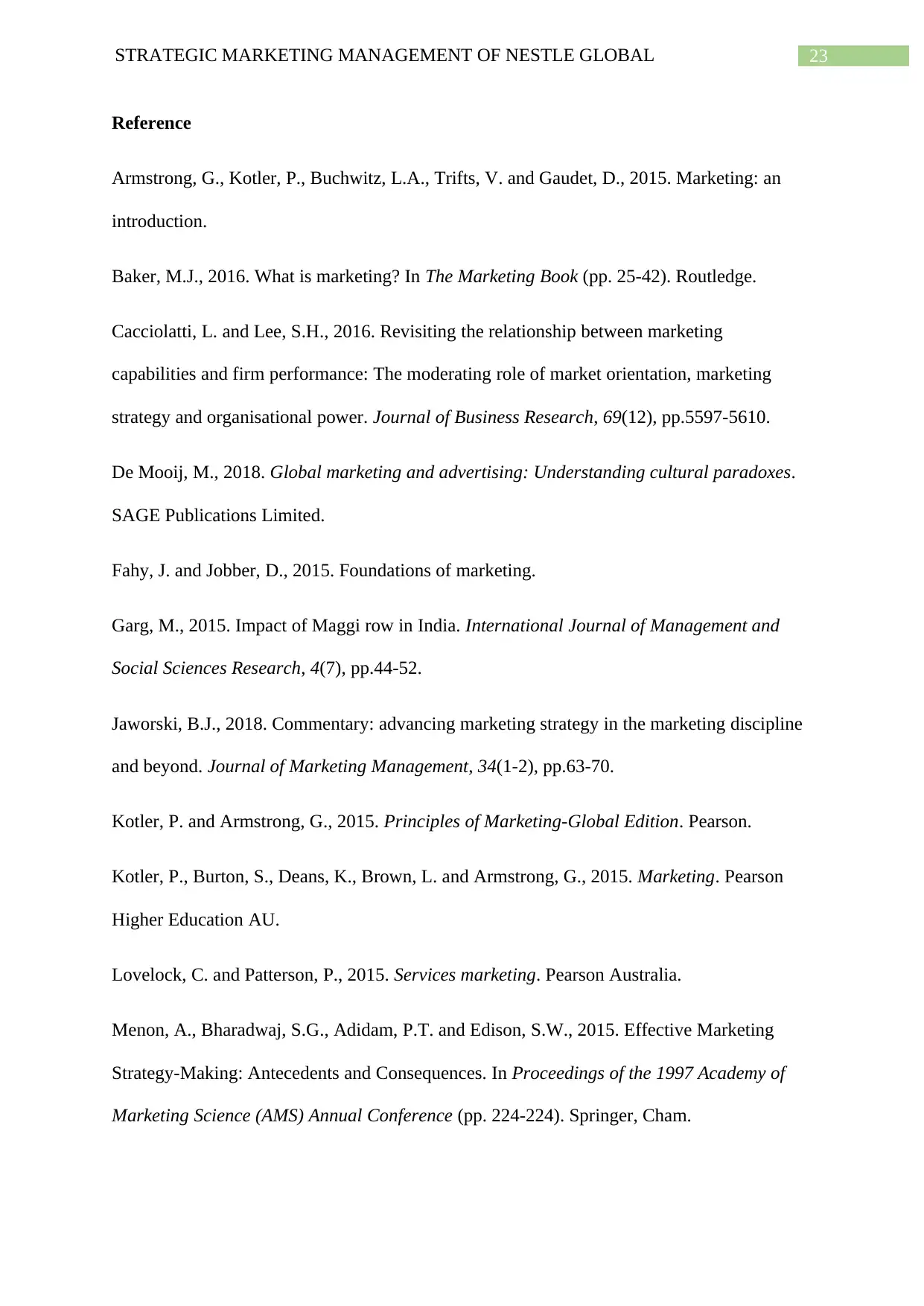
23STRATEGIC MARKETING MANAGEMENT OF NESTLE GLOBAL
Reference
Armstrong, G., Kotler, P., Buchwitz, L.A., Trifts, V. and Gaudet, D., 2015. Marketing: an
introduction.
Baker, M.J., 2016. What is marketing? In The Marketing Book (pp. 25-42). Routledge.
Cacciolatti, L. and Lee, S.H., 2016. Revisiting the relationship between marketing
capabilities and firm performance: The moderating role of market orientation, marketing
strategy and organisational power. Journal of Business Research, 69(12), pp.5597-5610.
De Mooij, M., 2018. Global marketing and advertising: Understanding cultural paradoxes.
SAGE Publications Limited.
Fahy, J. and Jobber, D., 2015. Foundations of marketing.
Garg, M., 2015. Impact of Maggi row in India. International Journal of Management and
Social Sciences Research, 4(7), pp.44-52.
Jaworski, B.J., 2018. Commentary: advancing marketing strategy in the marketing discipline
and beyond. Journal of Marketing Management, 34(1-2), pp.63-70.
Kotler, P. and Armstrong, G., 2015. Principles of Marketing-Global Edition. Pearson.
Kotler, P., Burton, S., Deans, K., Brown, L. and Armstrong, G., 2015. Marketing. Pearson
Higher Education AU.
Lovelock, C. and Patterson, P., 2015. Services marketing. Pearson Australia.
Menon, A., Bharadwaj, S.G., Adidam, P.T. and Edison, S.W., 2015. Effective Marketing
Strategy-Making: Antecedents and Consequences. In Proceedings of the 1997 Academy of
Marketing Science (AMS) Annual Conference (pp. 224-224). Springer, Cham.
Reference
Armstrong, G., Kotler, P., Buchwitz, L.A., Trifts, V. and Gaudet, D., 2015. Marketing: an
introduction.
Baker, M.J., 2016. What is marketing? In The Marketing Book (pp. 25-42). Routledge.
Cacciolatti, L. and Lee, S.H., 2016. Revisiting the relationship between marketing
capabilities and firm performance: The moderating role of market orientation, marketing
strategy and organisational power. Journal of Business Research, 69(12), pp.5597-5610.
De Mooij, M., 2018. Global marketing and advertising: Understanding cultural paradoxes.
SAGE Publications Limited.
Fahy, J. and Jobber, D., 2015. Foundations of marketing.
Garg, M., 2015. Impact of Maggi row in India. International Journal of Management and
Social Sciences Research, 4(7), pp.44-52.
Jaworski, B.J., 2018. Commentary: advancing marketing strategy in the marketing discipline
and beyond. Journal of Marketing Management, 34(1-2), pp.63-70.
Kotler, P. and Armstrong, G., 2015. Principles of Marketing-Global Edition. Pearson.
Kotler, P., Burton, S., Deans, K., Brown, L. and Armstrong, G., 2015. Marketing. Pearson
Higher Education AU.
Lovelock, C. and Patterson, P., 2015. Services marketing. Pearson Australia.
Menon, A., Bharadwaj, S.G., Adidam, P.T. and Edison, S.W., 2015. Effective Marketing
Strategy-Making: Antecedents and Consequences. In Proceedings of the 1997 Academy of
Marketing Science (AMS) Annual Conference (pp. 224-224). Springer, Cham.
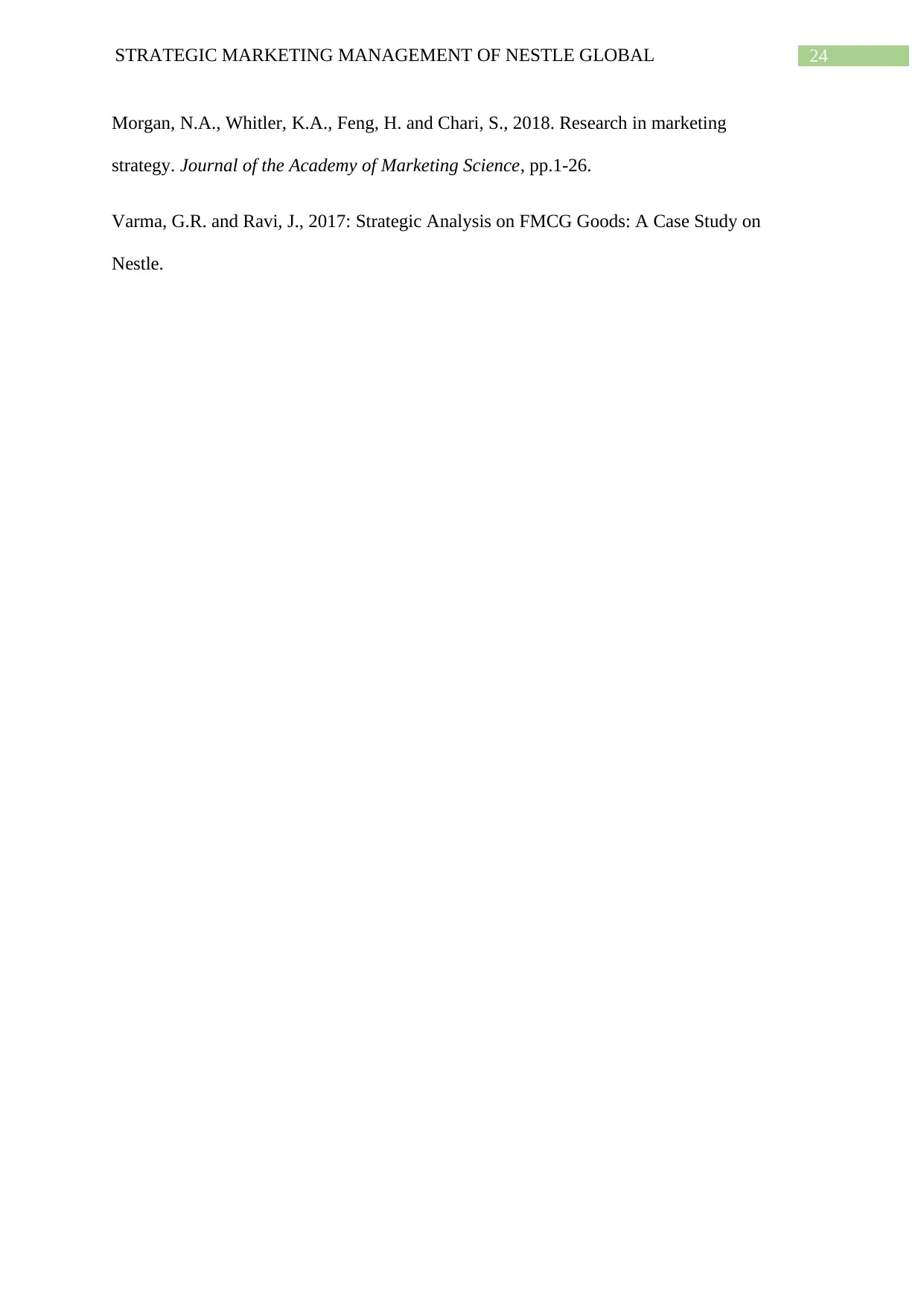
24STRATEGIC MARKETING MANAGEMENT OF NESTLE GLOBAL
Morgan, N.A., Whitler, K.A., Feng, H. and Chari, S., 2018. Research in marketing
strategy. Journal of the Academy of Marketing Science, pp.1-26.
Varma, G.R. and Ravi, J., 2017: Strategic Analysis on FMCG Goods: A Case Study on
Nestle.
Morgan, N.A., Whitler, K.A., Feng, H. and Chari, S., 2018. Research in marketing
strategy. Journal of the Academy of Marketing Science, pp.1-26.
Varma, G.R. and Ravi, J., 2017: Strategic Analysis on FMCG Goods: A Case Study on
Nestle.
Paraphrase This Document
Need a fresh take? Get an instant paraphrase of this document with our AI Paraphraser
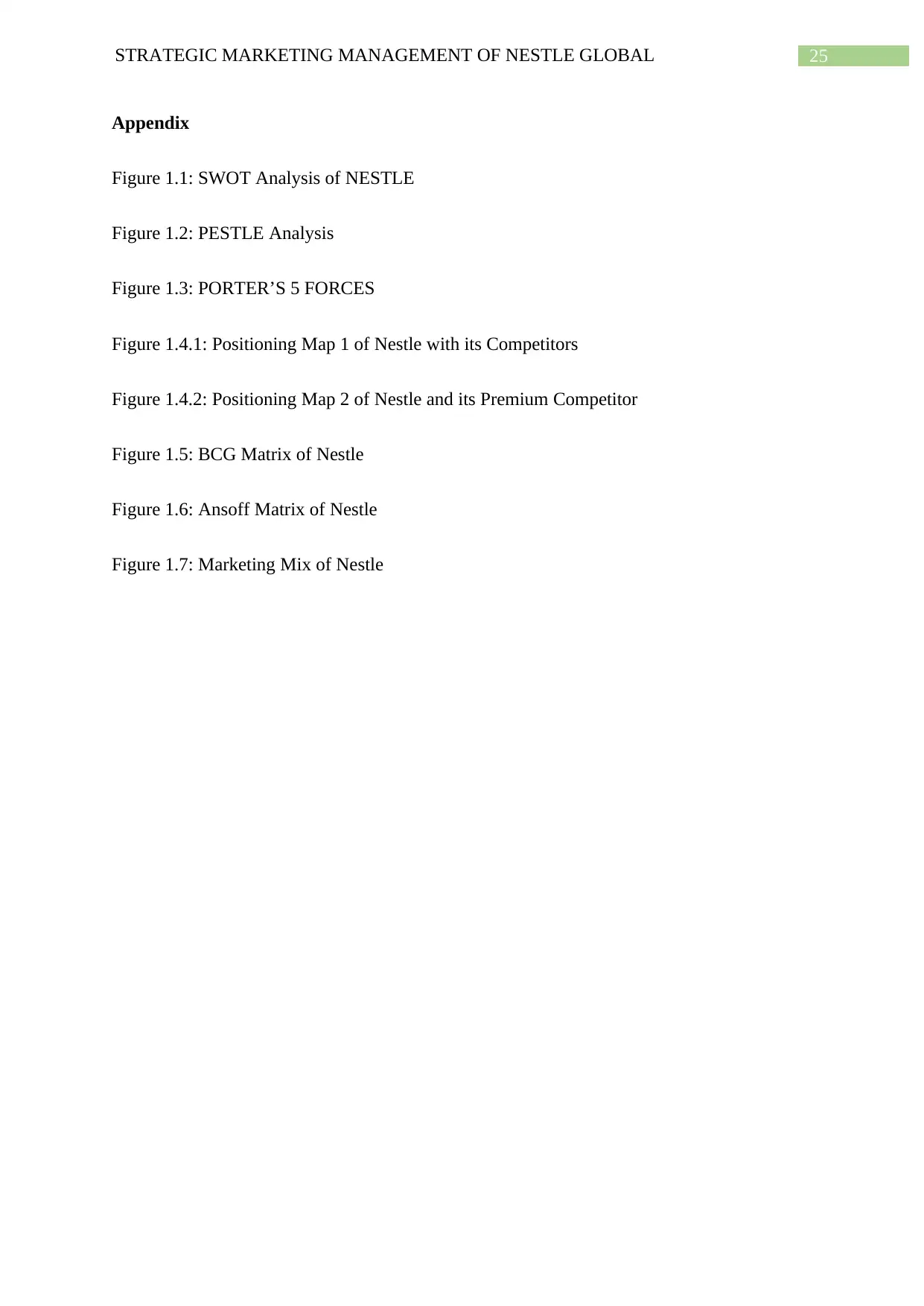
25STRATEGIC MARKETING MANAGEMENT OF NESTLE GLOBAL
Appendix
Figure 1.1: SWOT Analysis of NESTLE
Figure 1.2: PESTLE Analysis
Figure 1.3: PORTER’S 5 FORCES
Figure 1.4.1: Positioning Map 1 of Nestle with its Competitors
Figure 1.4.2: Positioning Map 2 of Nestle and its Premium Competitor
Figure 1.5: BCG Matrix of Nestle
Figure 1.6: Ansoff Matrix of Nestle
Figure 1.7: Marketing Mix of Nestle
Appendix
Figure 1.1: SWOT Analysis of NESTLE
Figure 1.2: PESTLE Analysis
Figure 1.3: PORTER’S 5 FORCES
Figure 1.4.1: Positioning Map 1 of Nestle with its Competitors
Figure 1.4.2: Positioning Map 2 of Nestle and its Premium Competitor
Figure 1.5: BCG Matrix of Nestle
Figure 1.6: Ansoff Matrix of Nestle
Figure 1.7: Marketing Mix of Nestle
1 out of 26
Related Documents
Your All-in-One AI-Powered Toolkit for Academic Success.
+13062052269
info@desklib.com
Available 24*7 on WhatsApp / Email
![[object Object]](/_next/static/media/star-bottom.7253800d.svg)
Unlock your academic potential
© 2024 | Zucol Services PVT LTD | All rights reserved.





